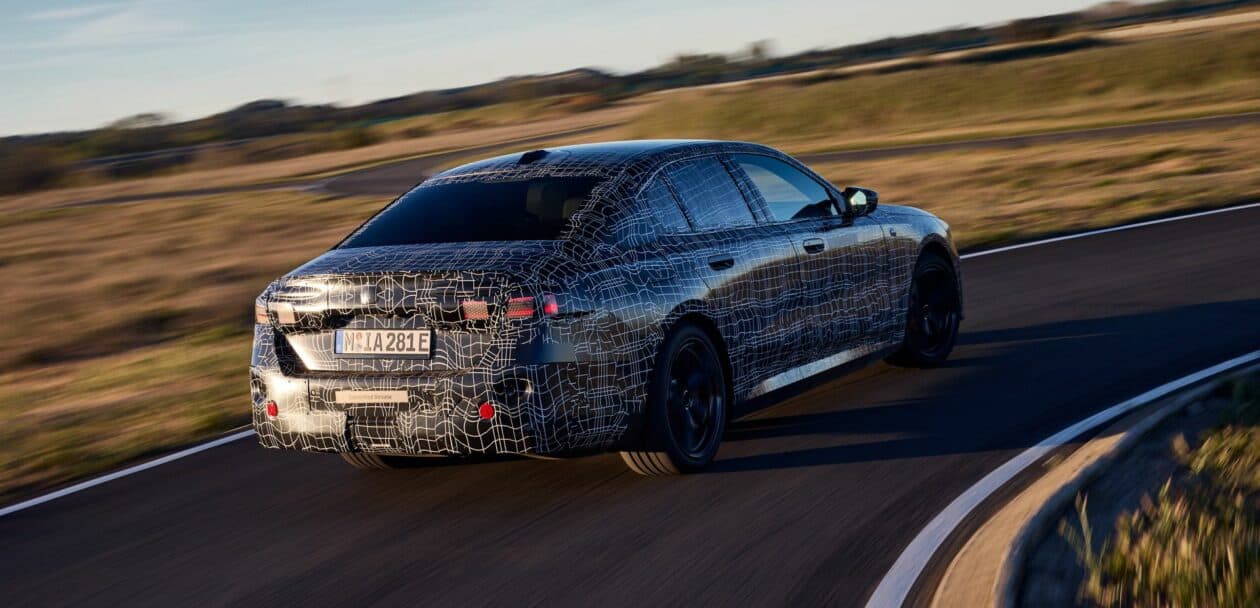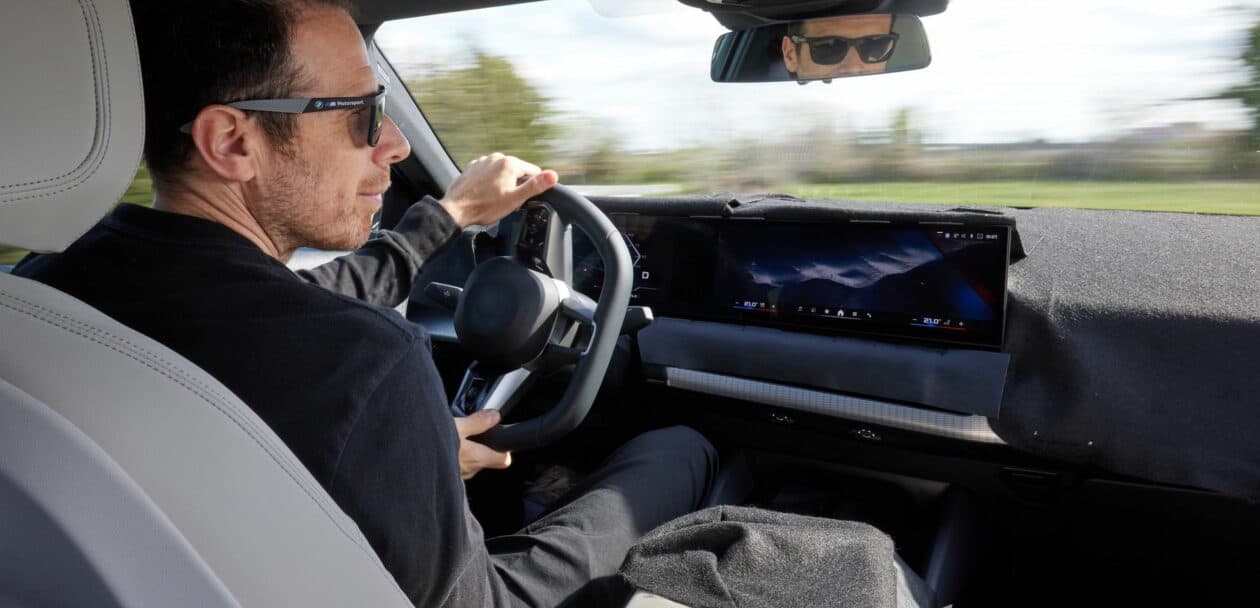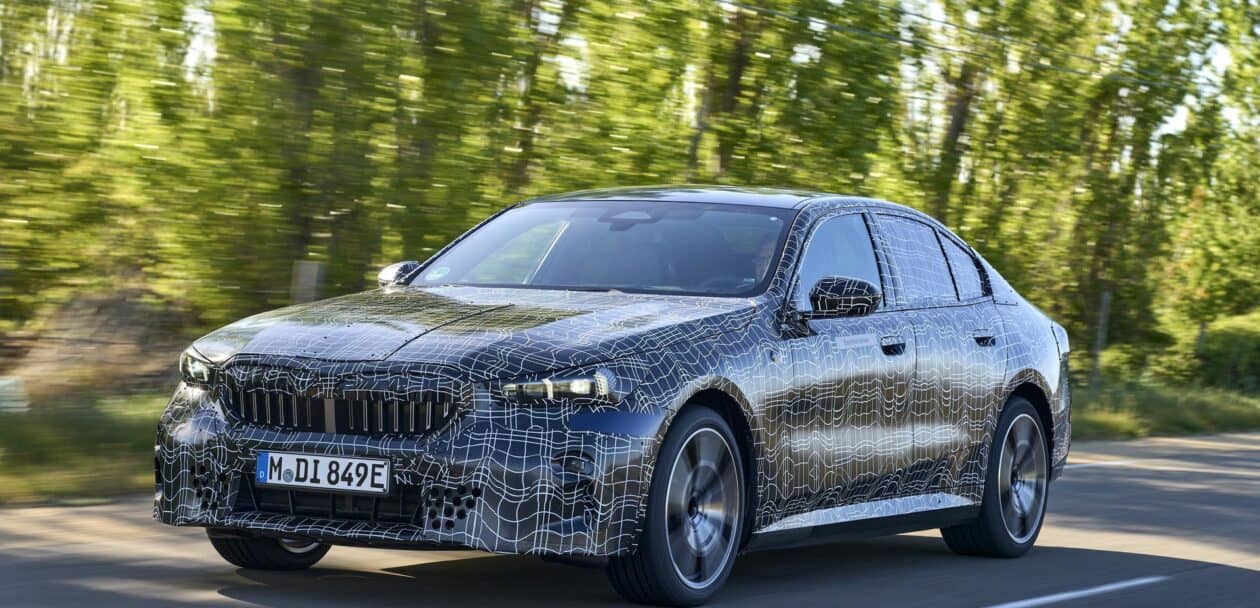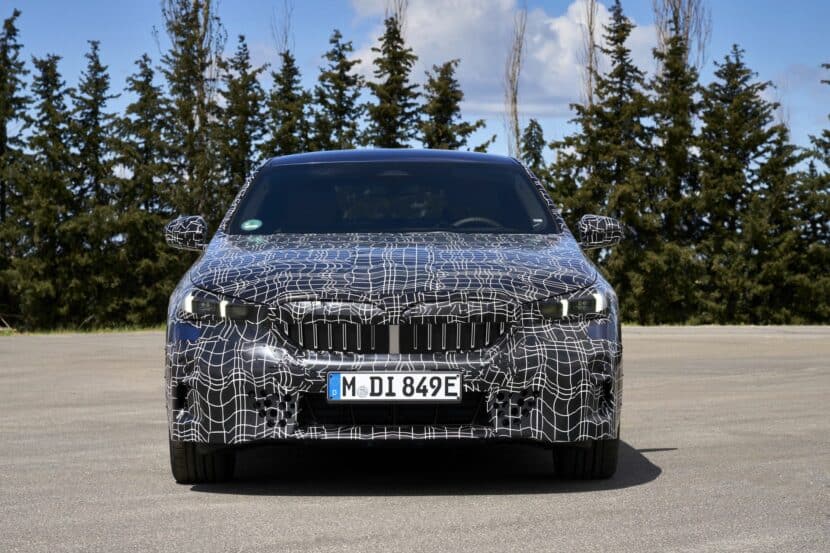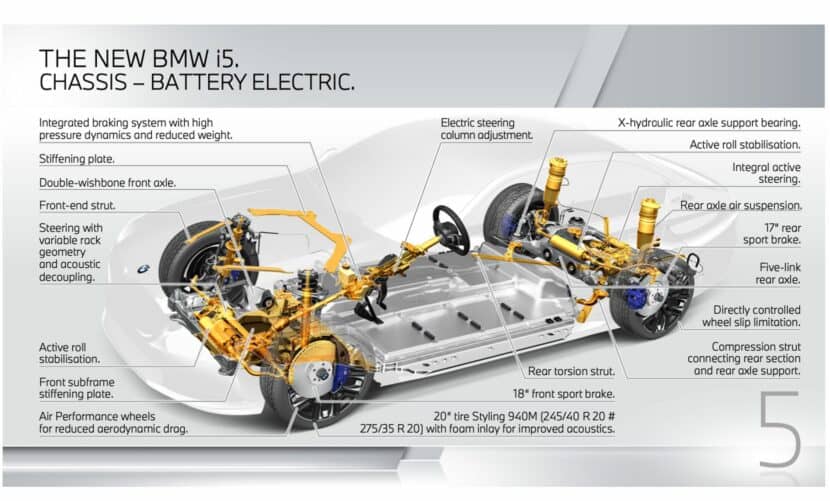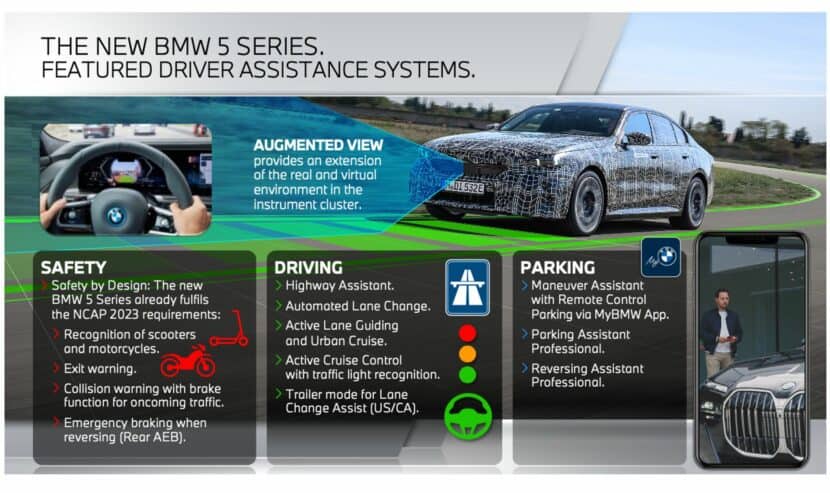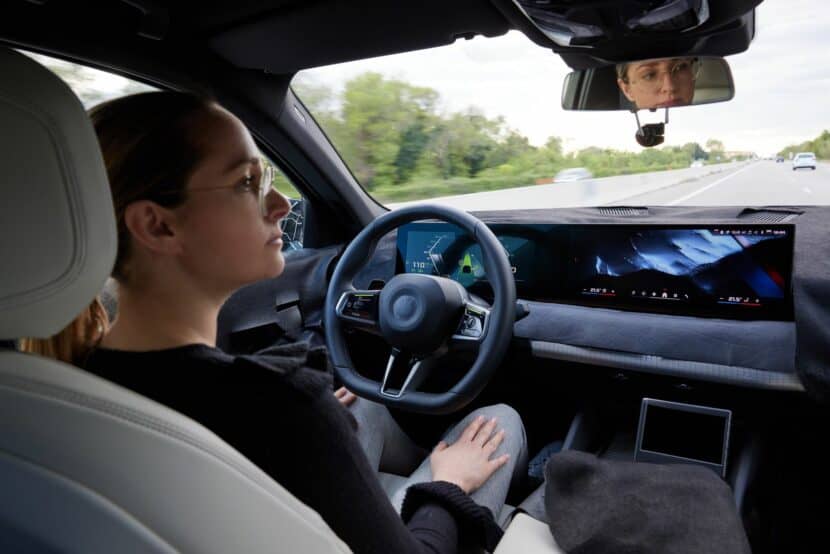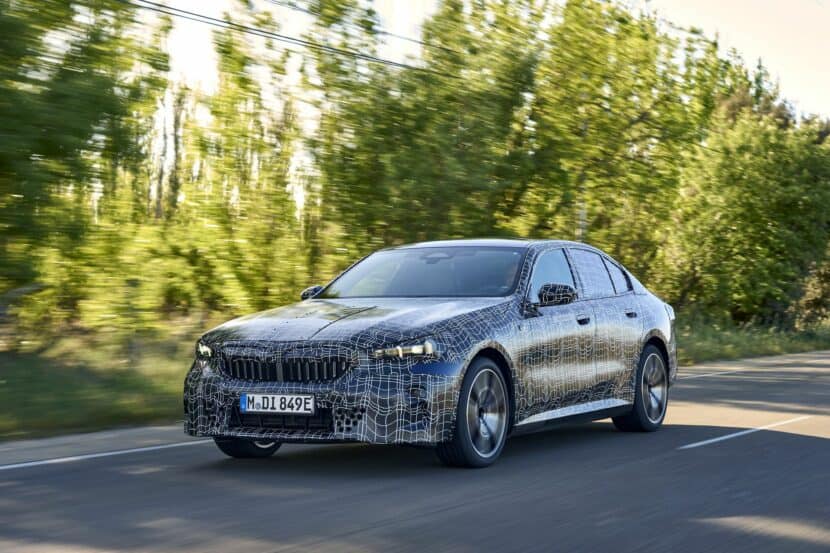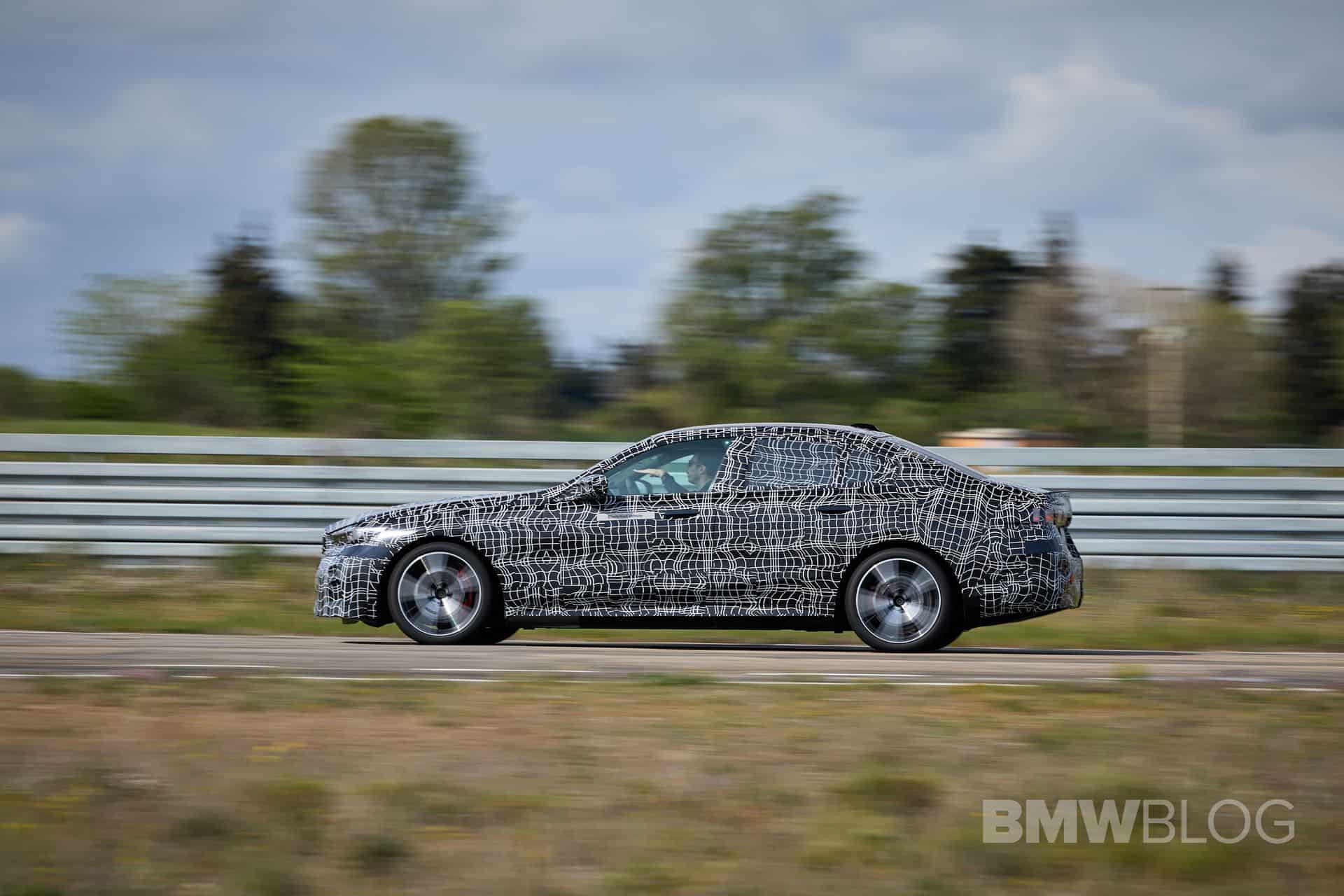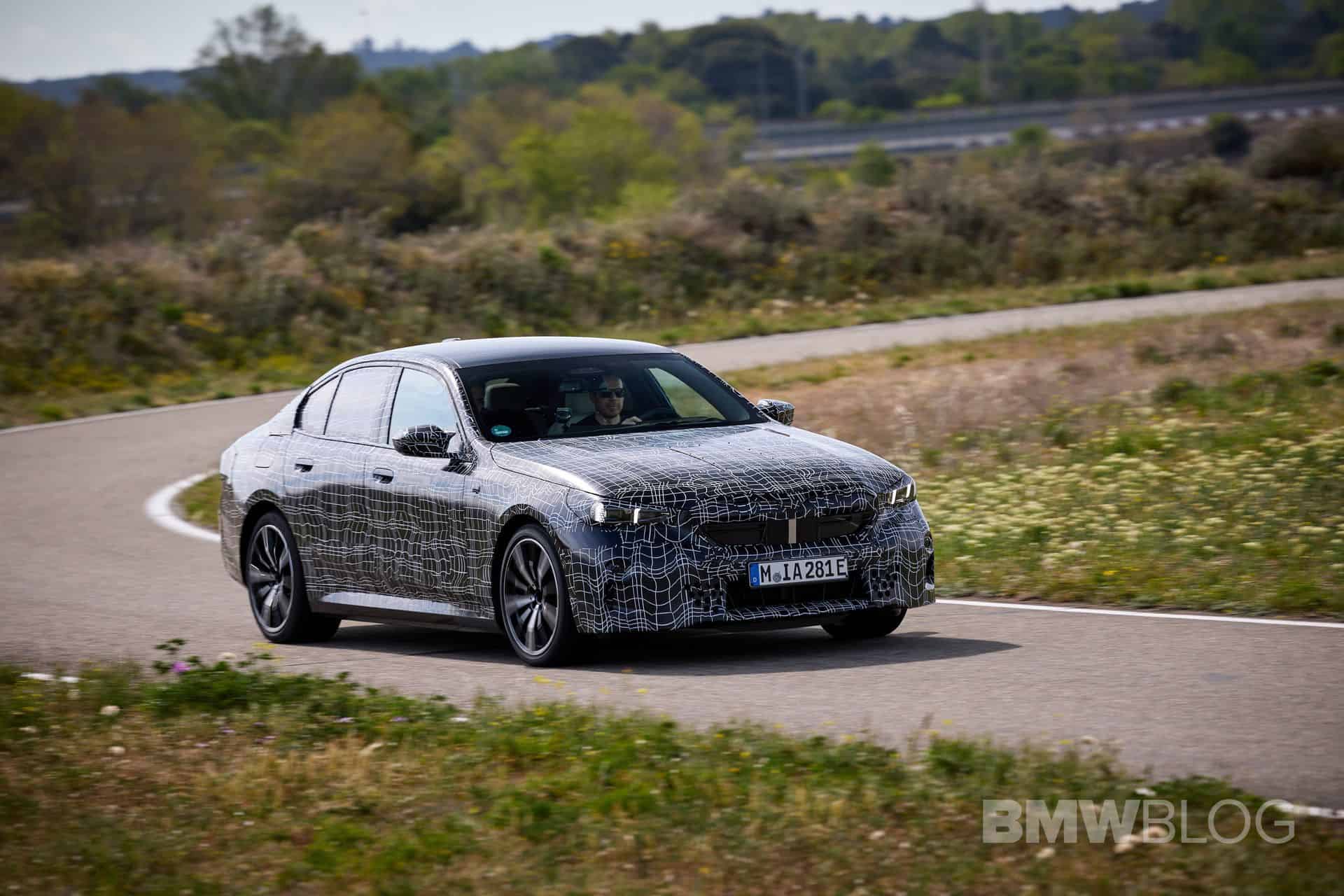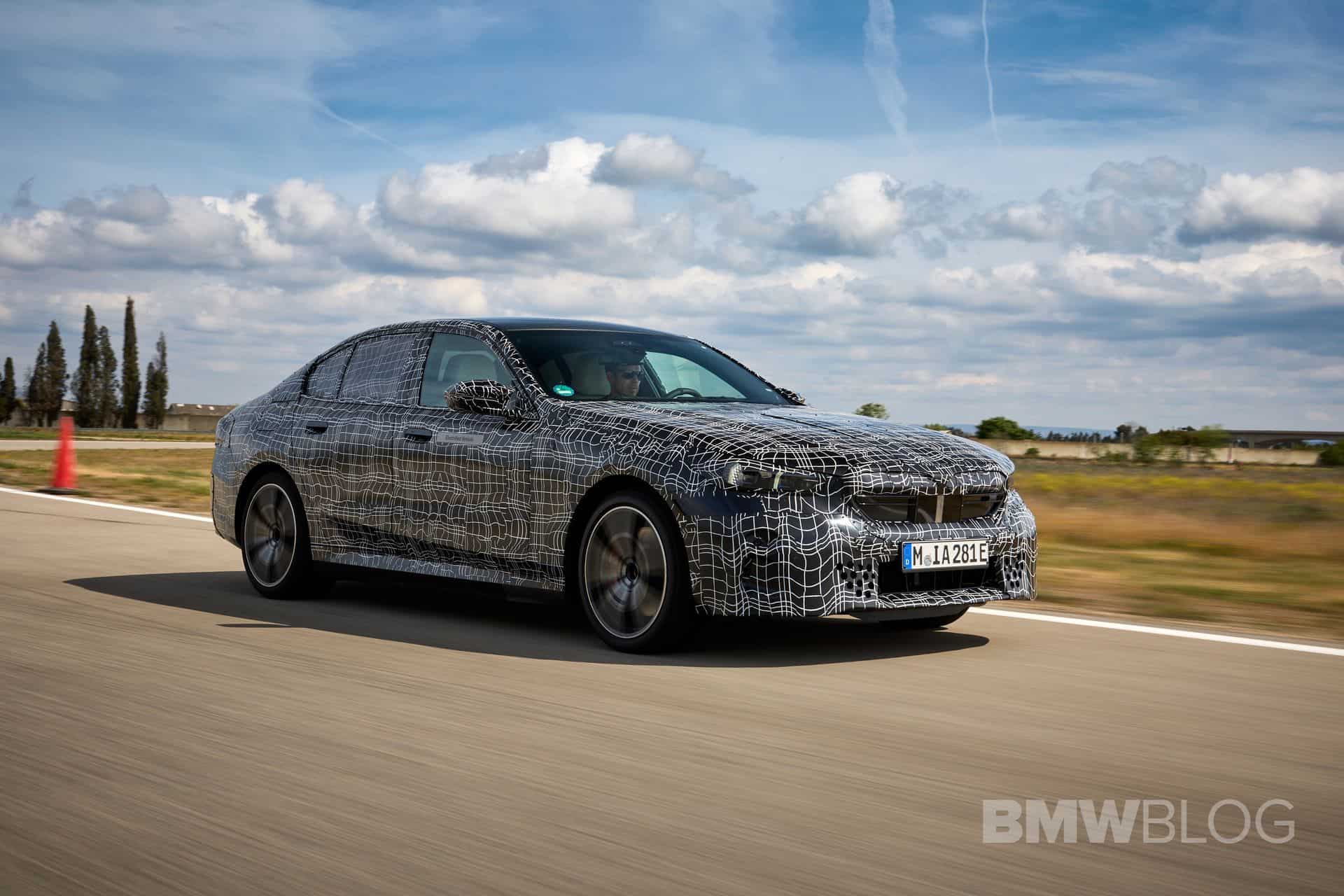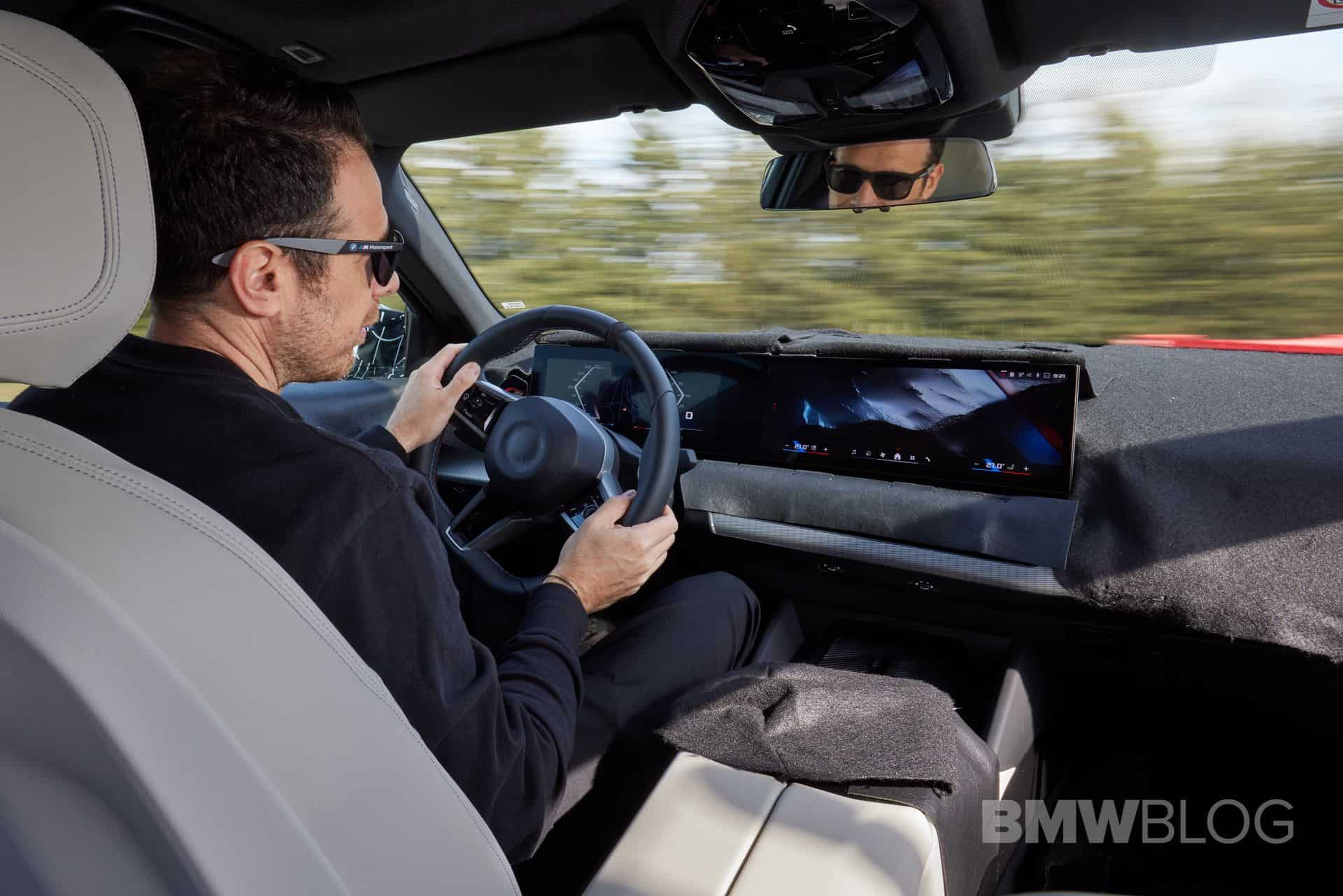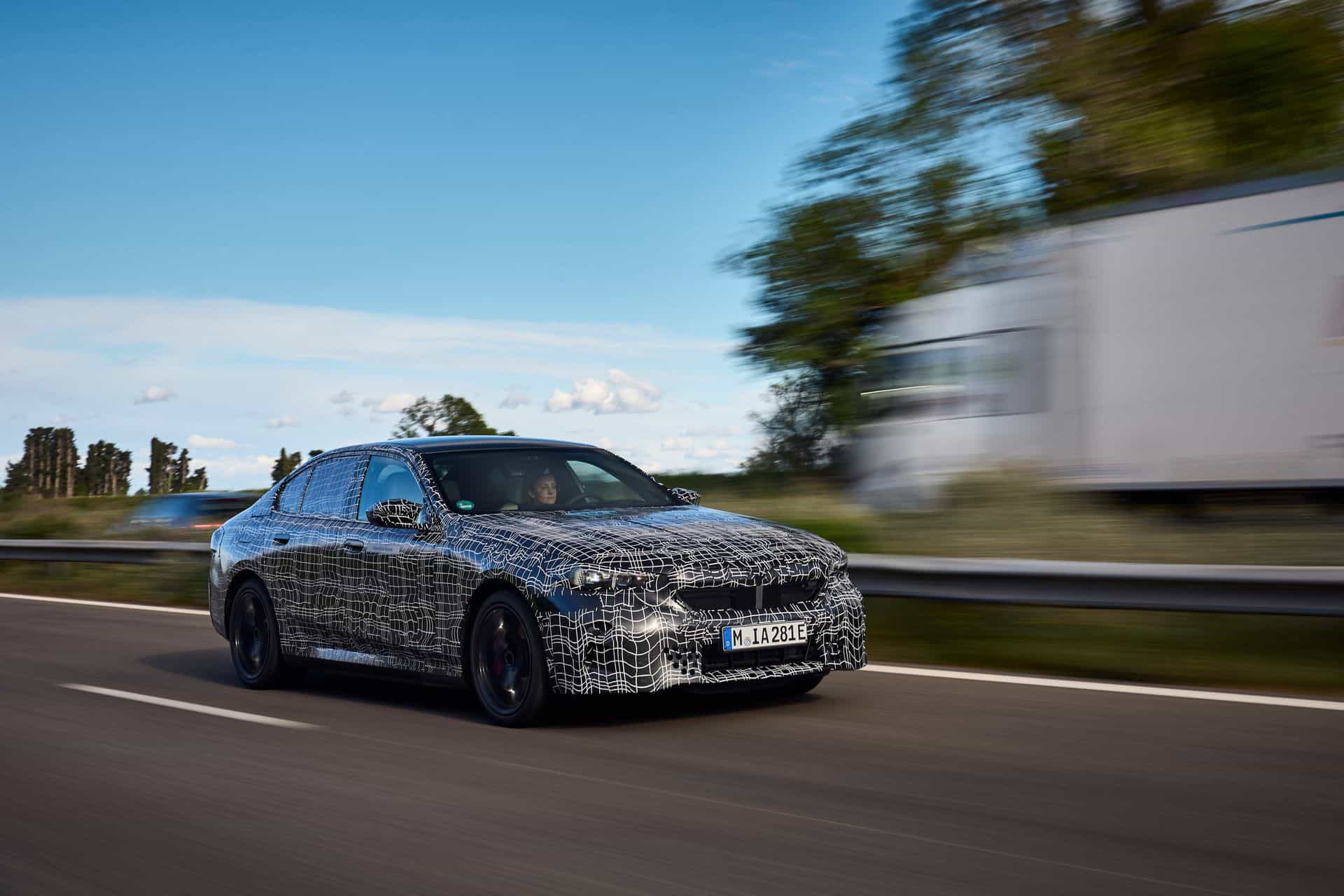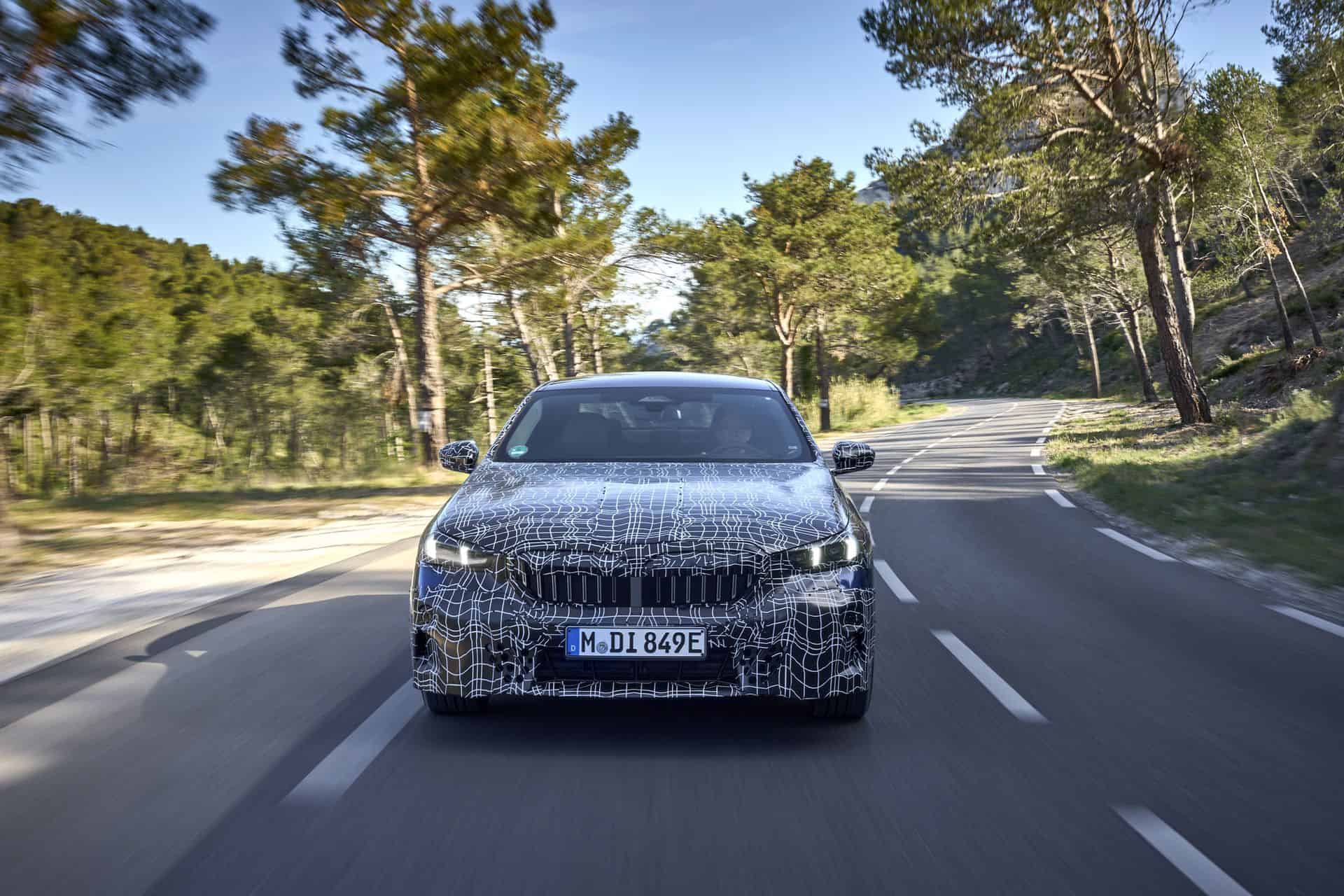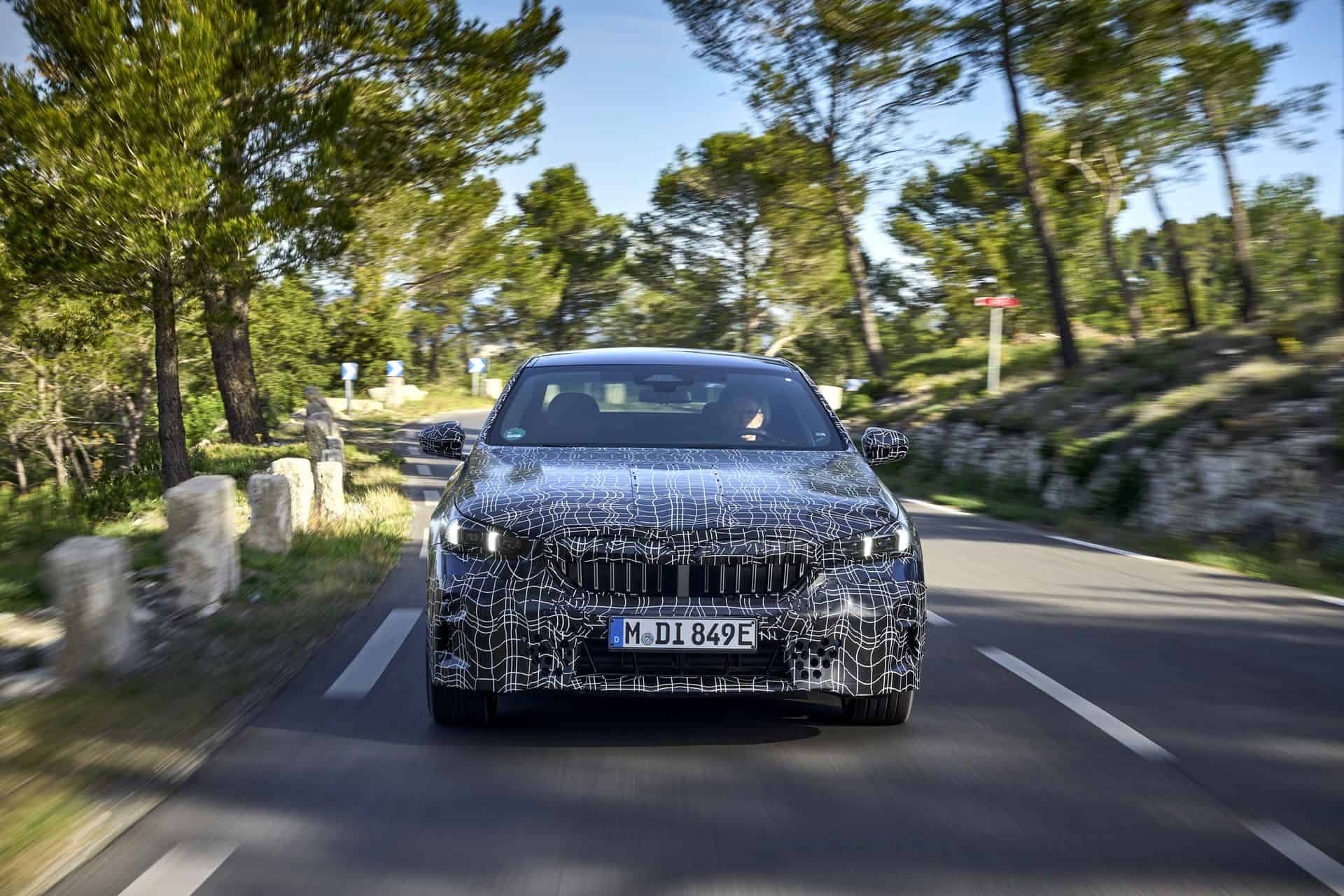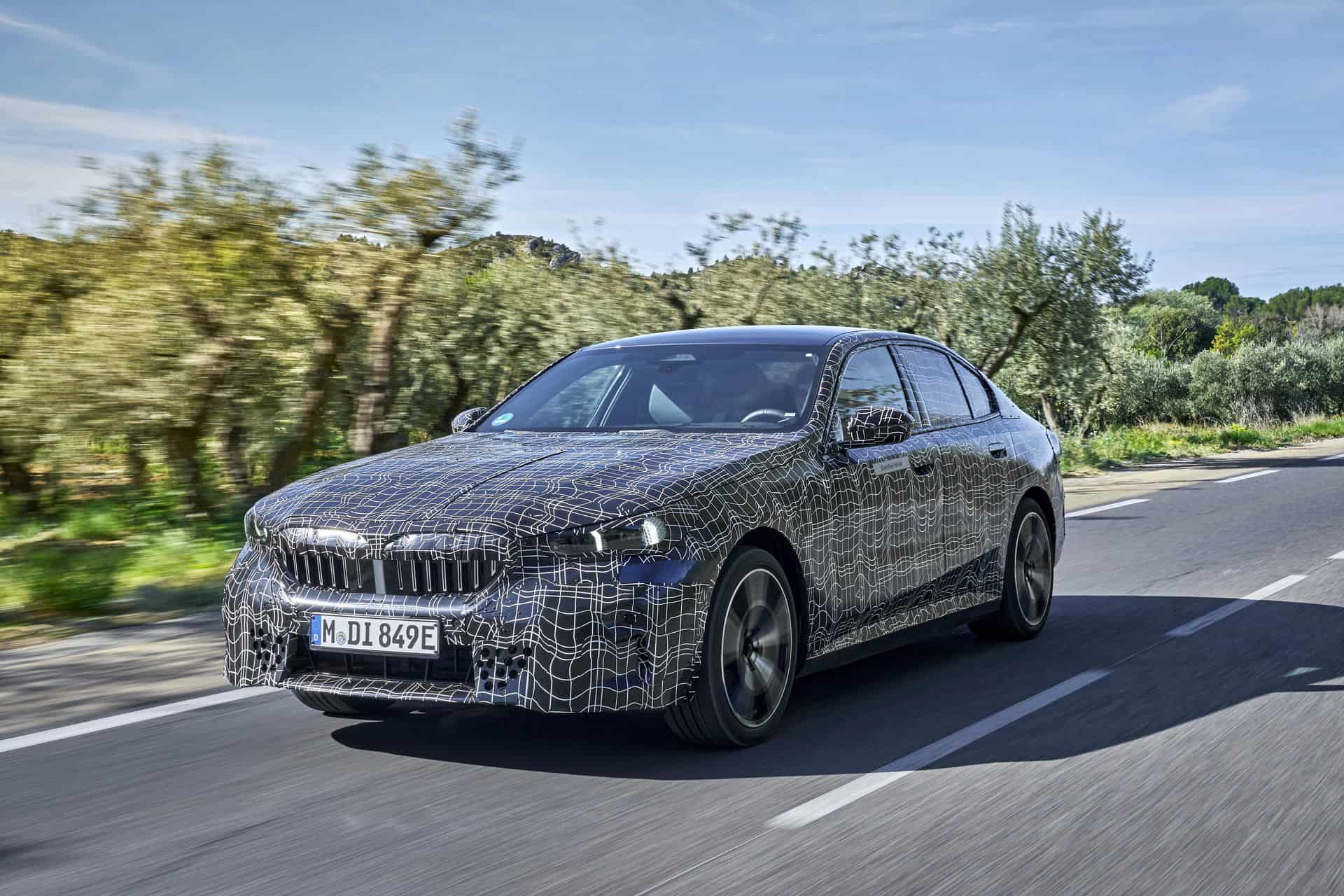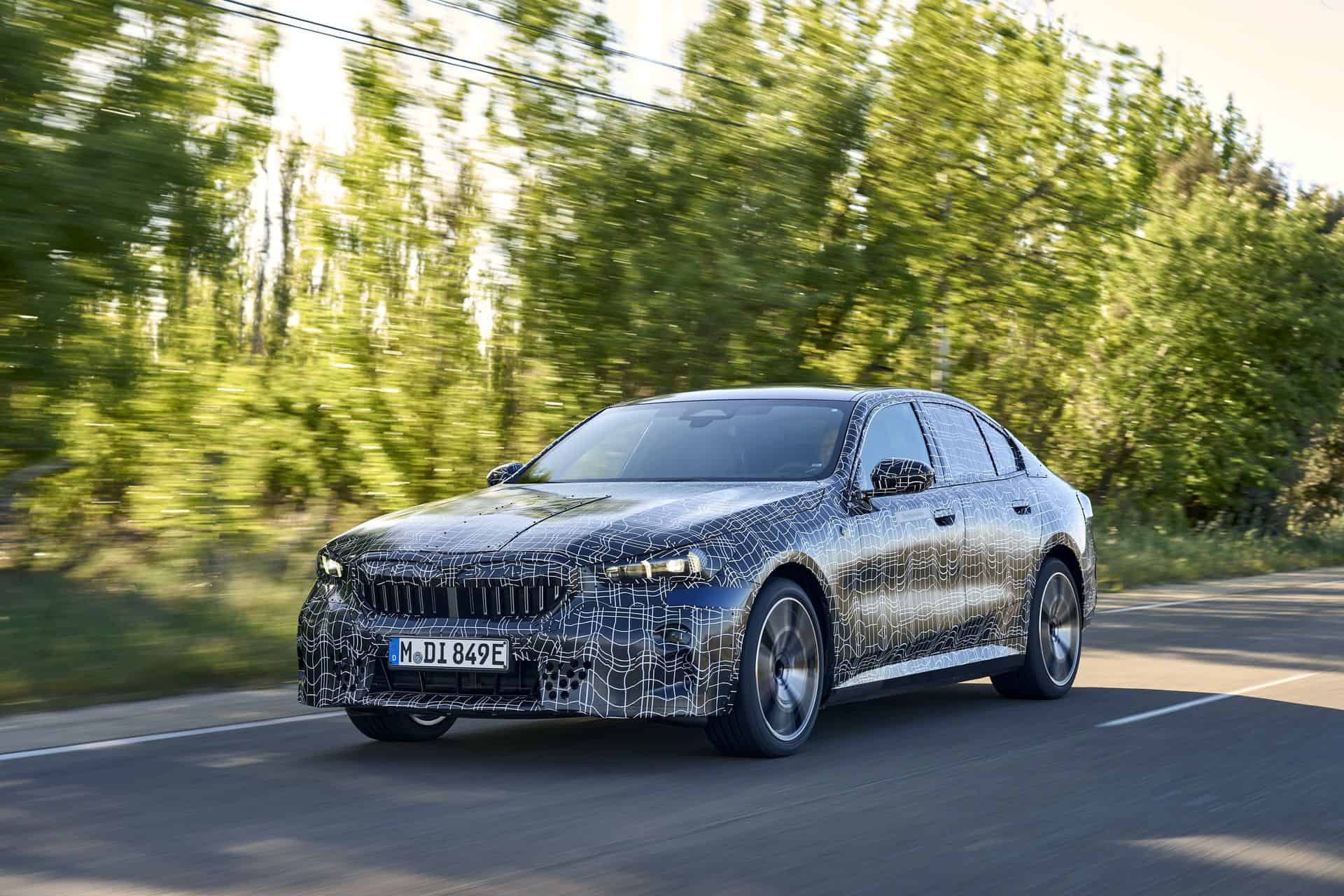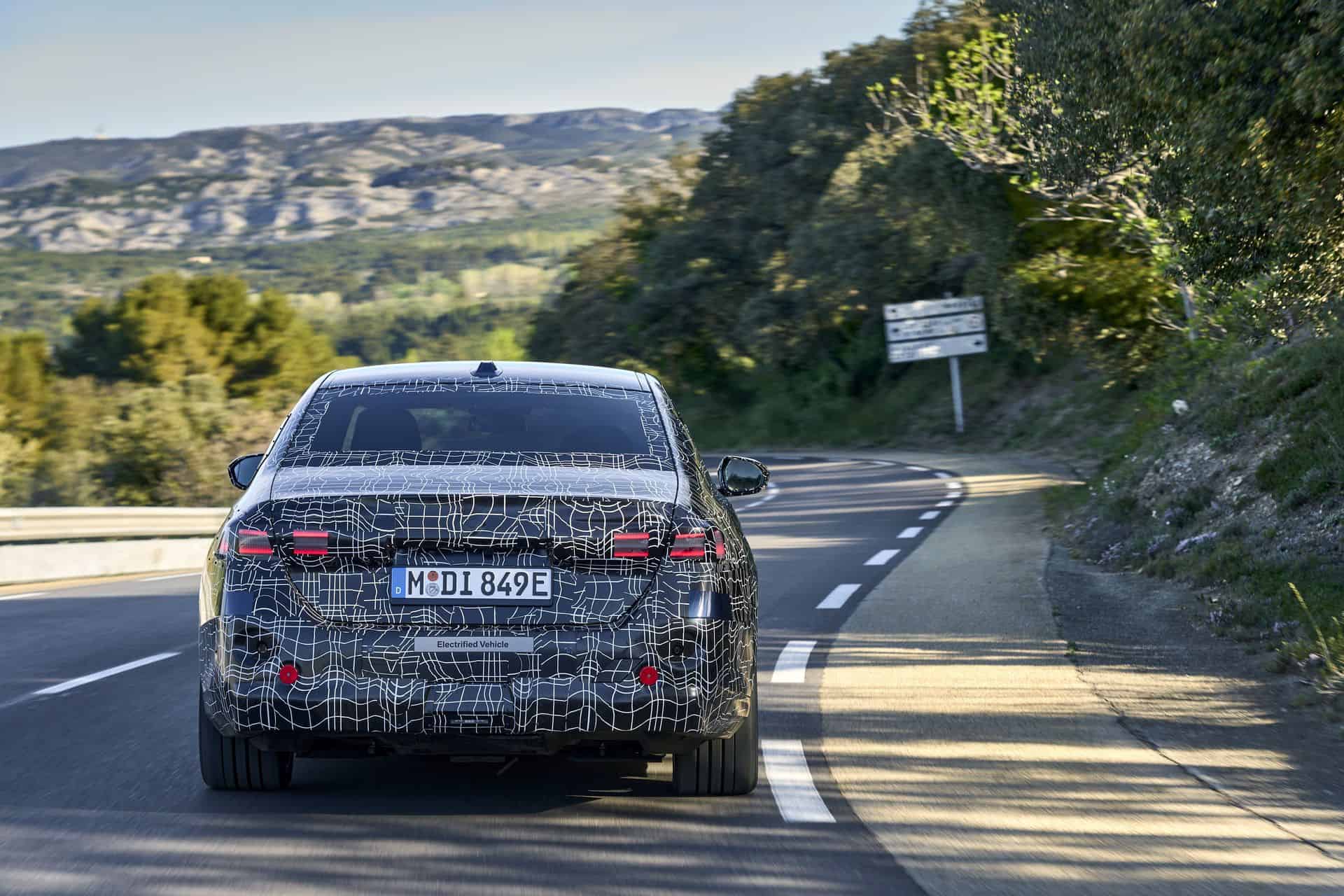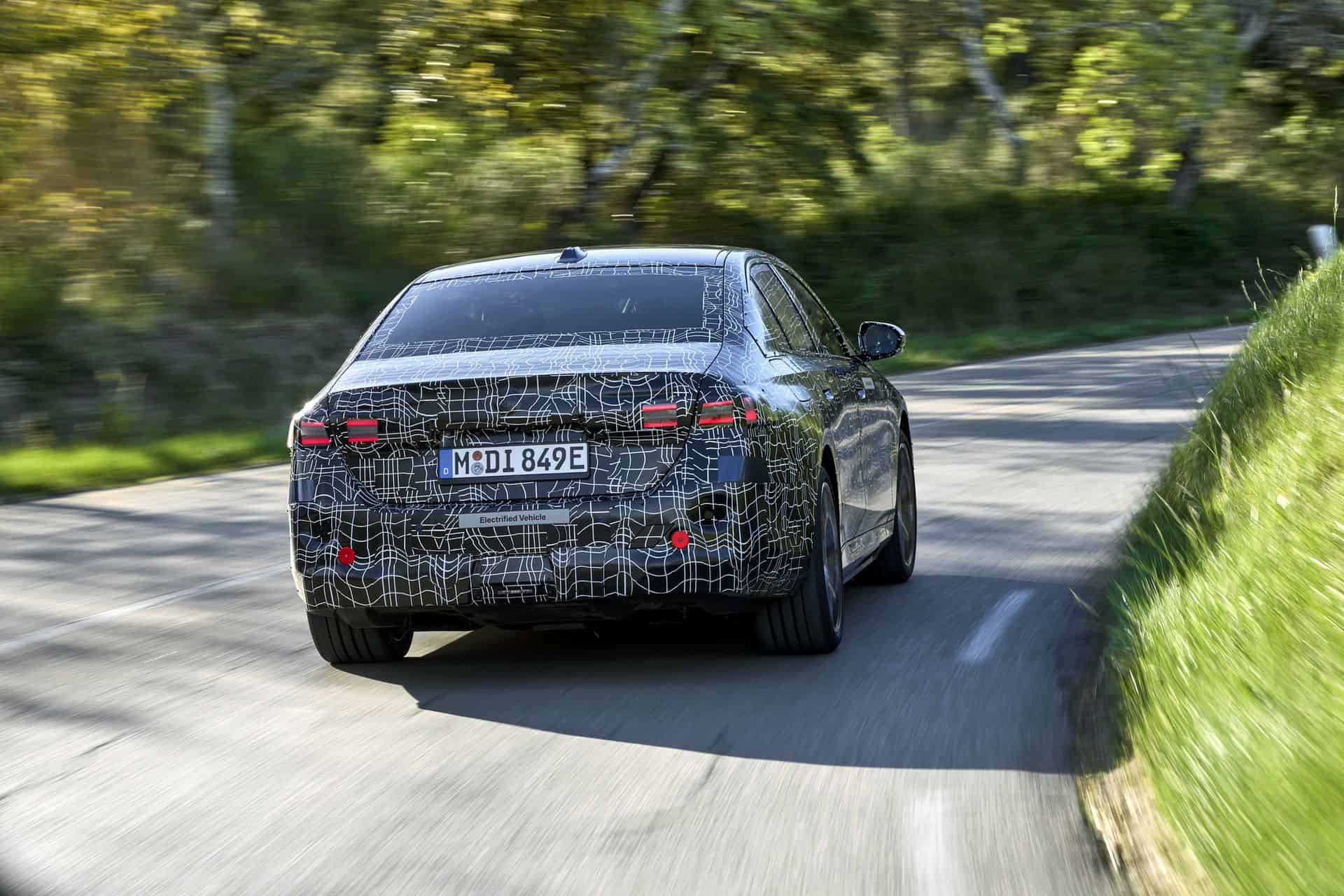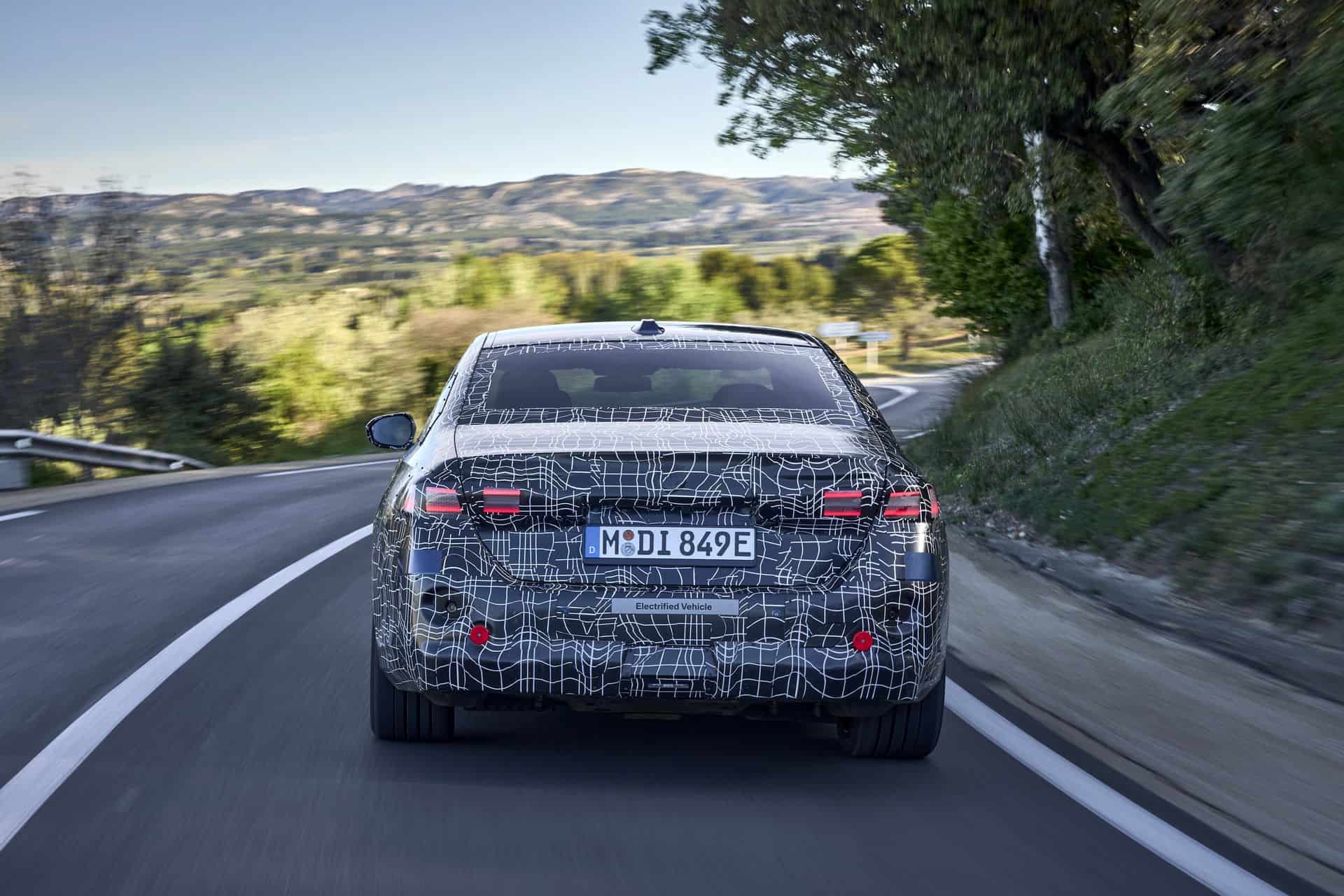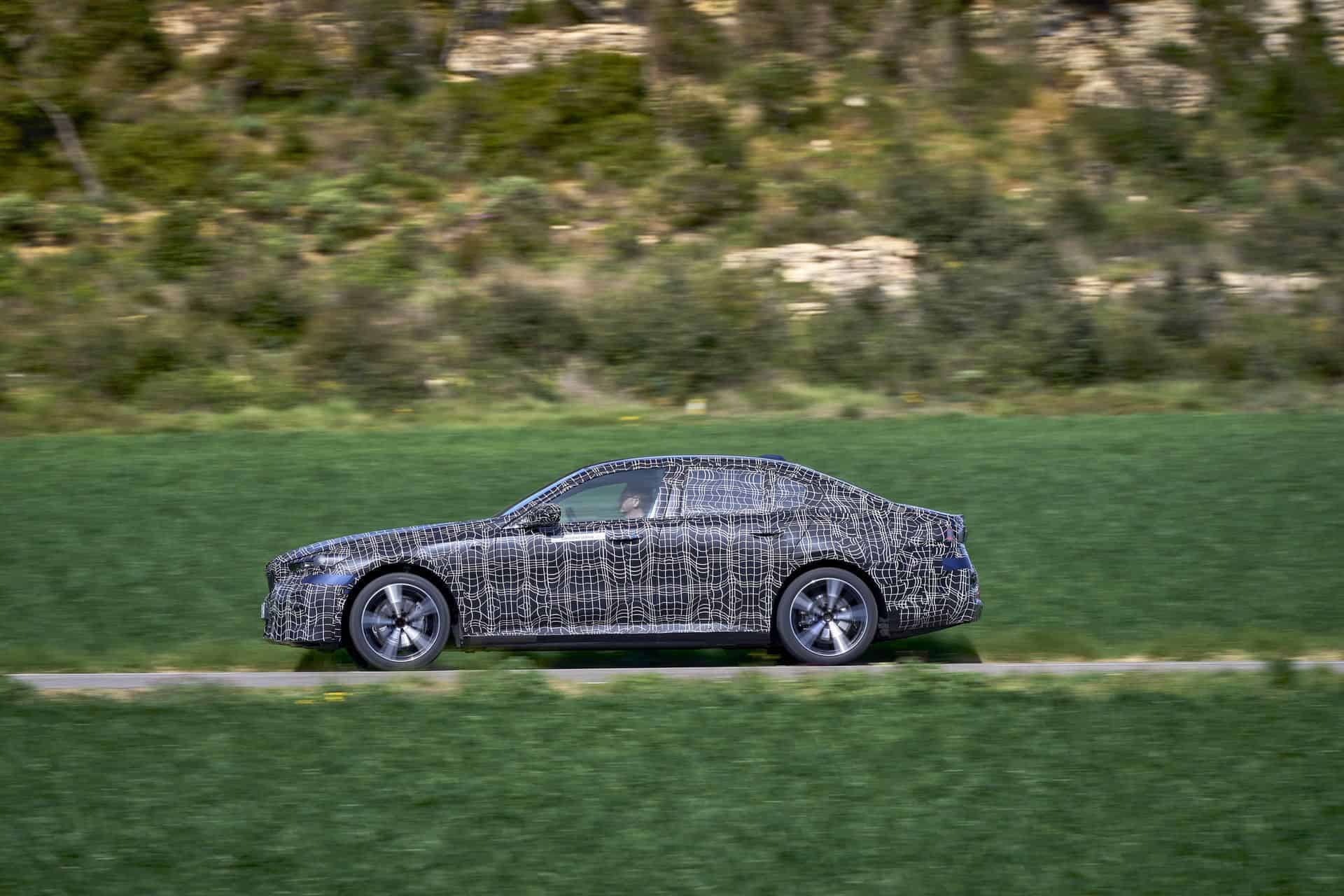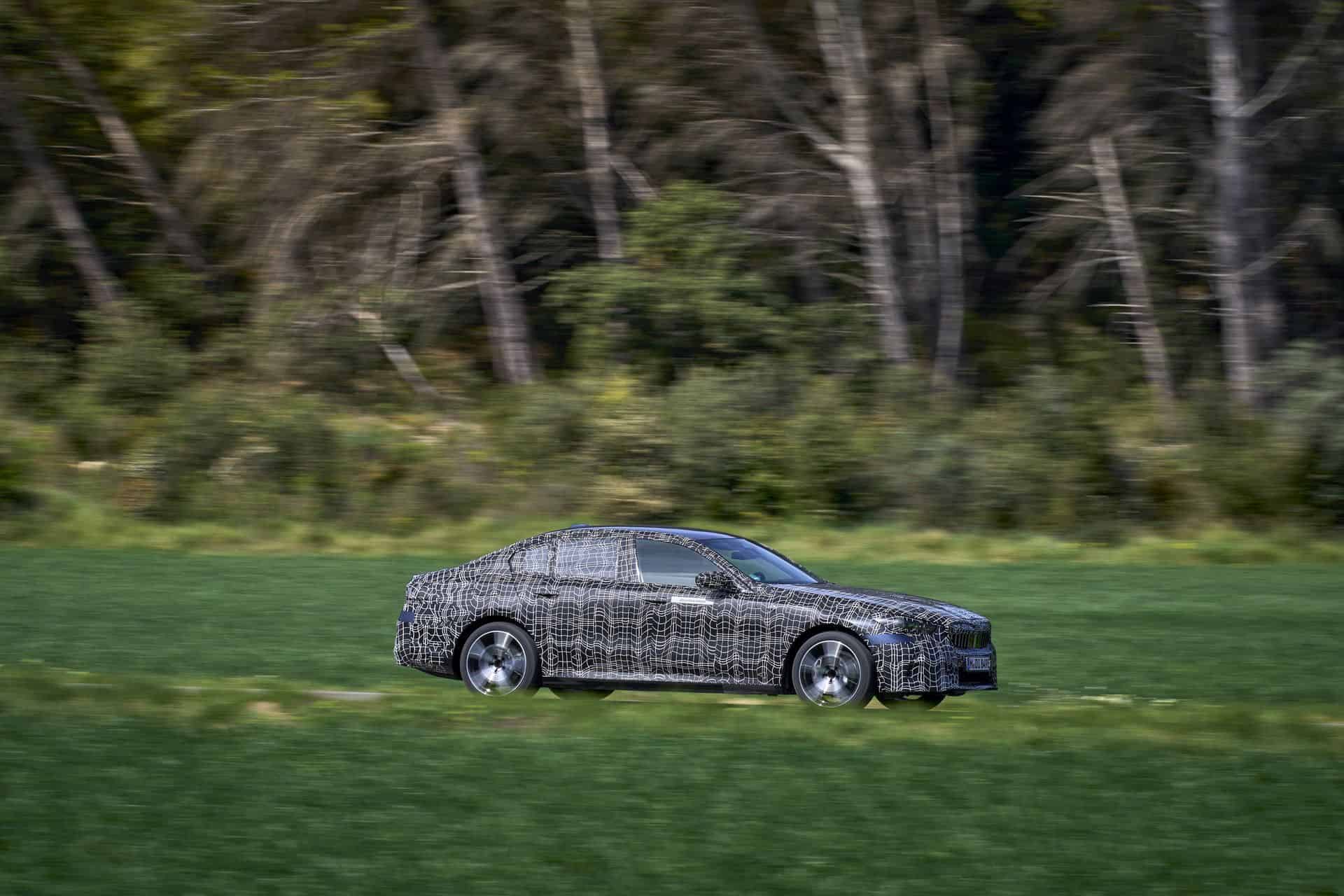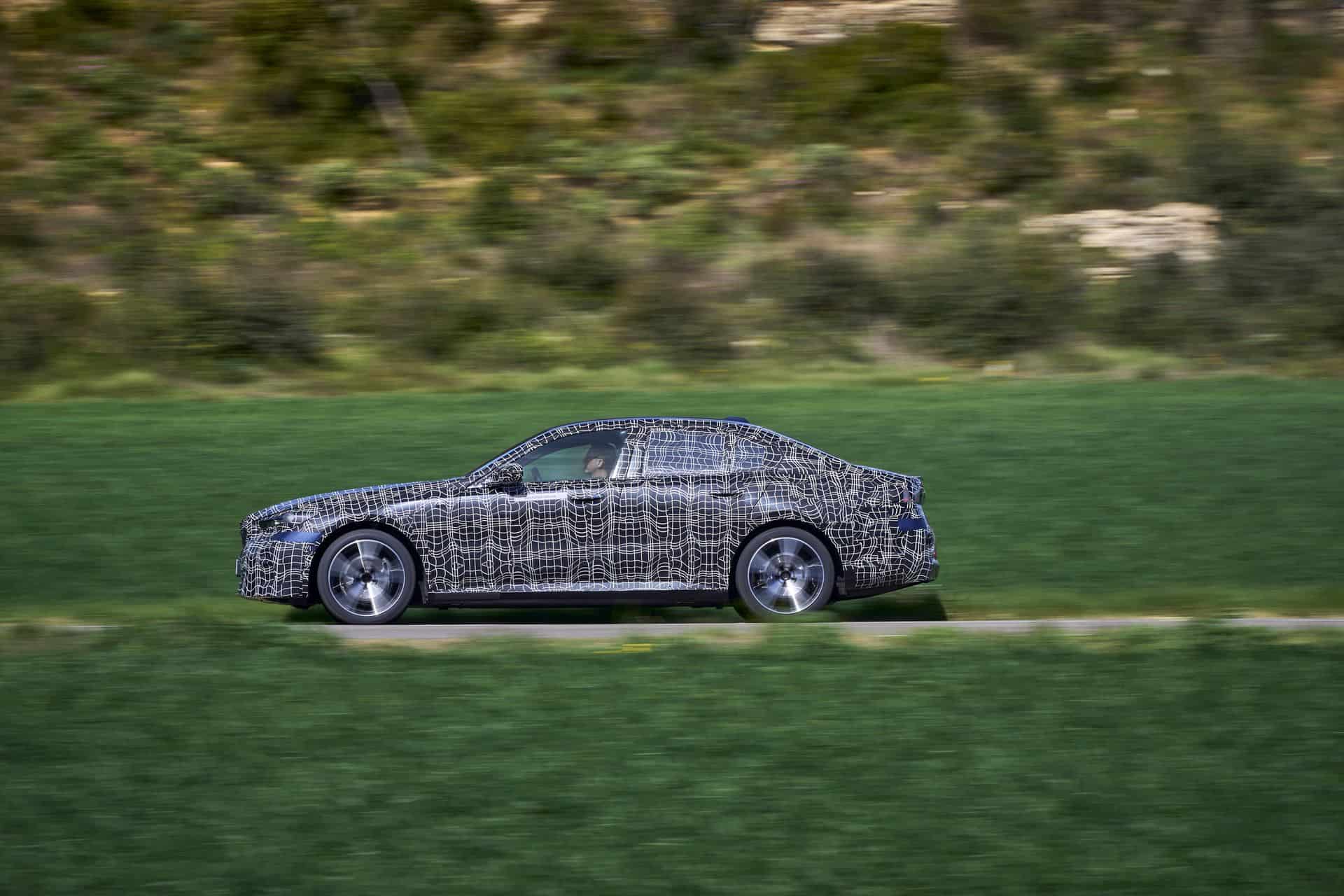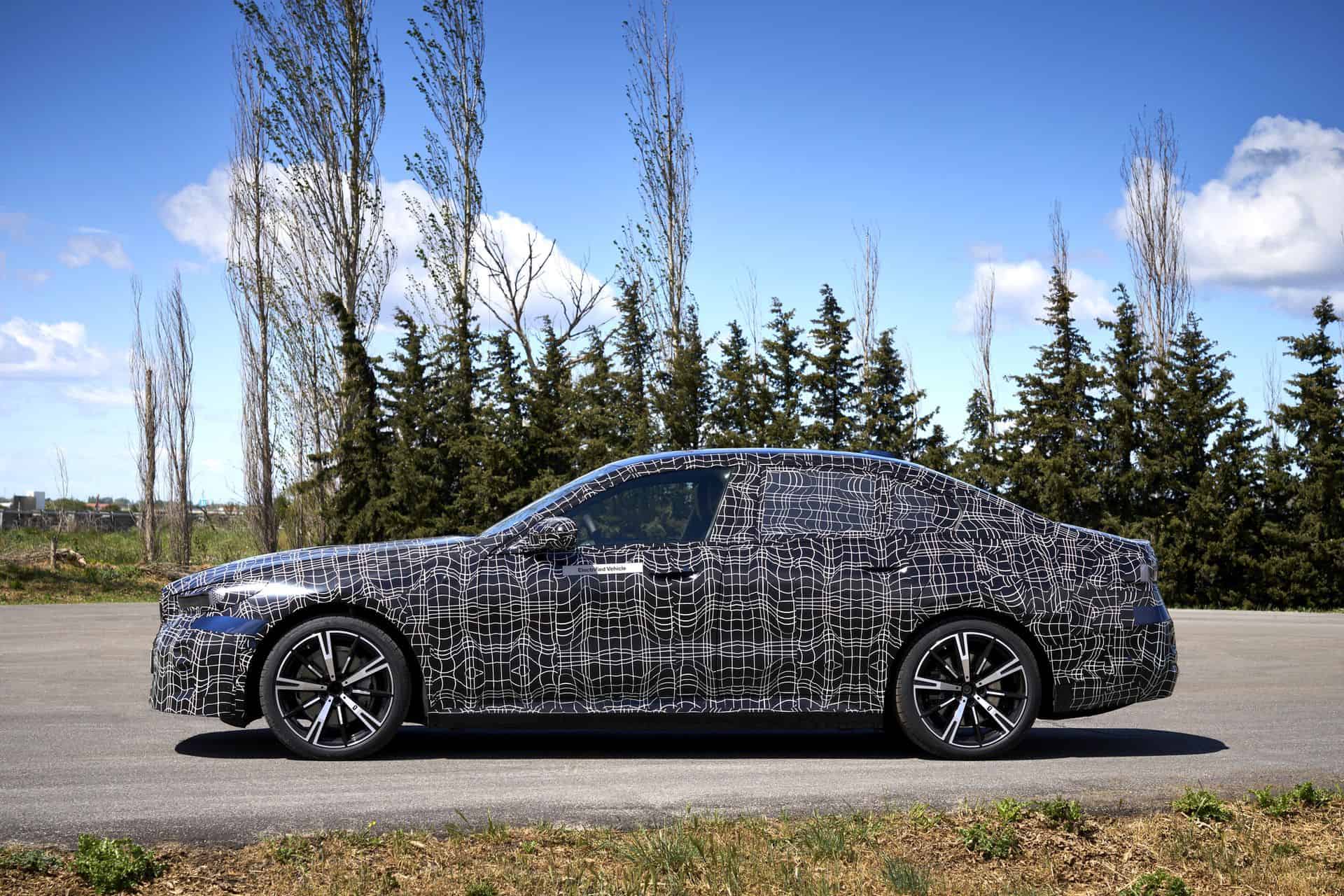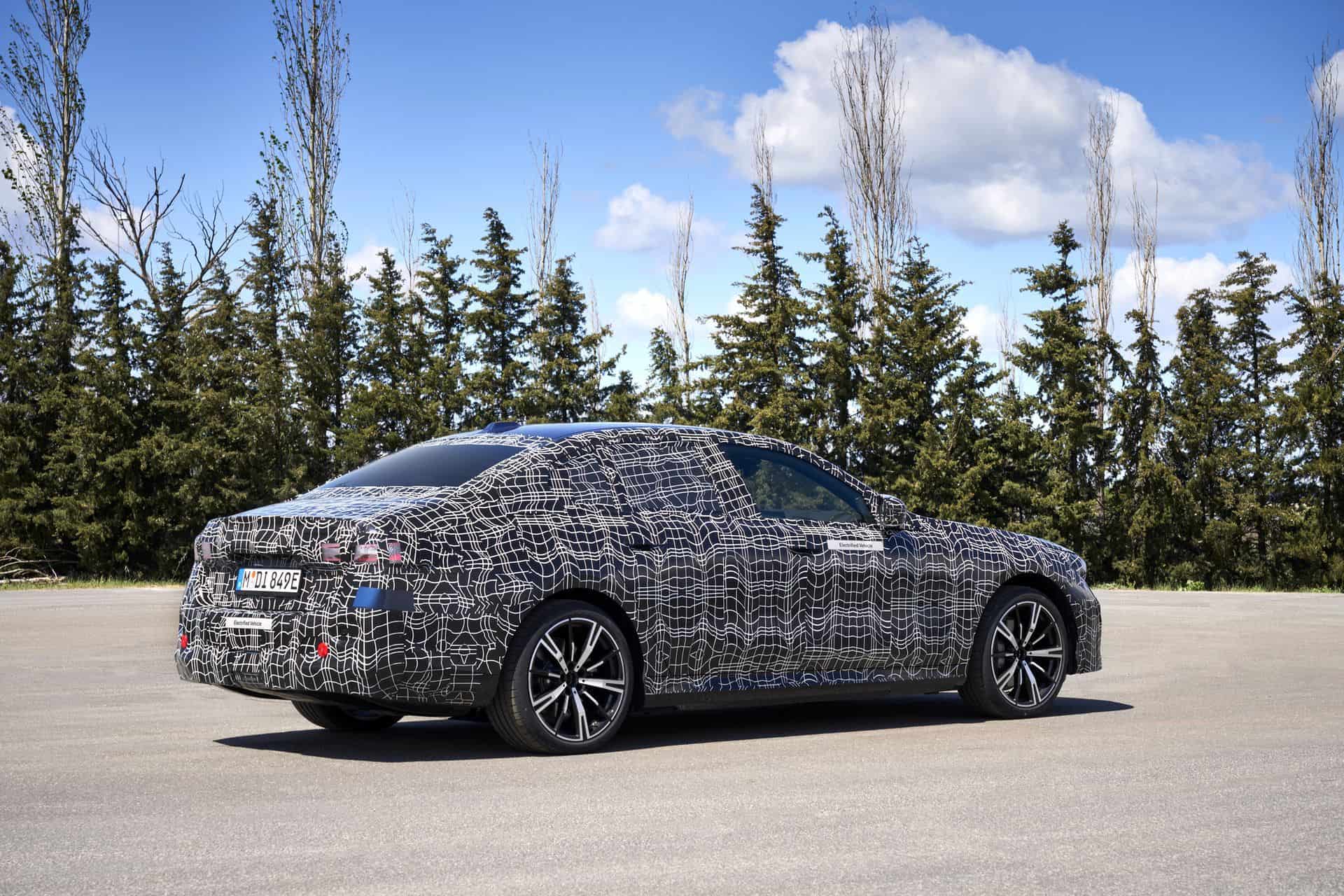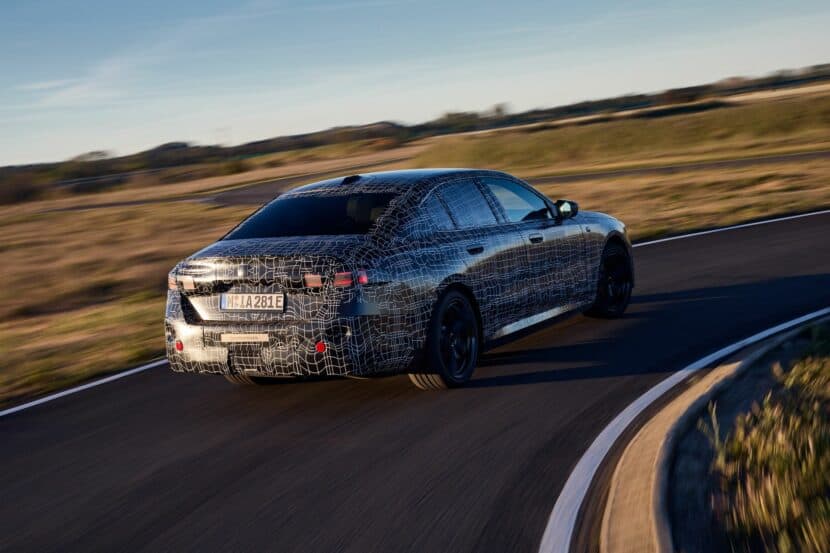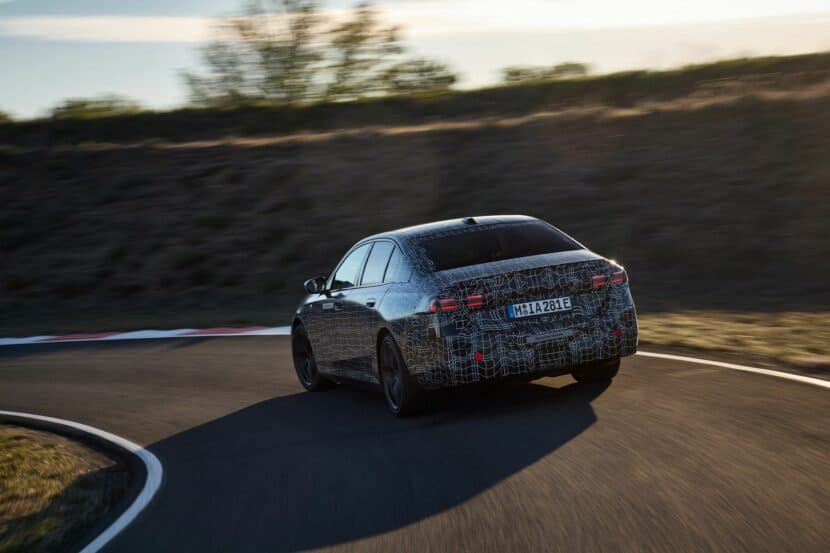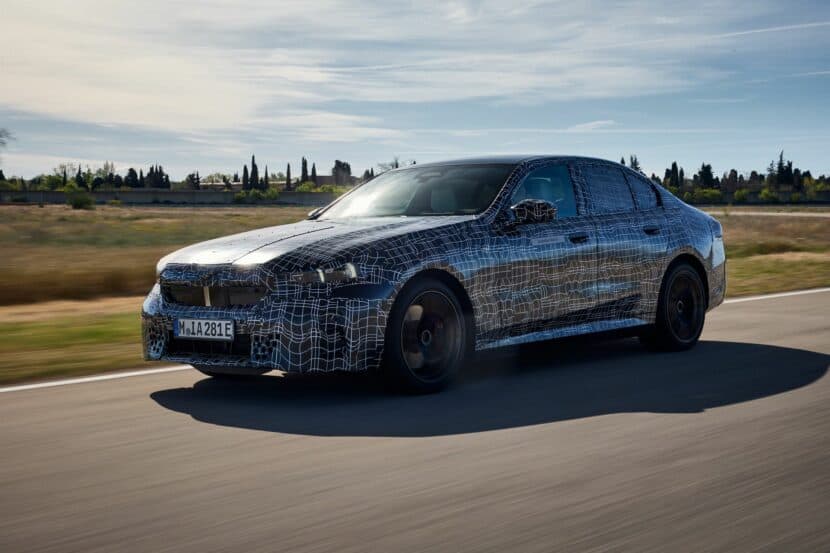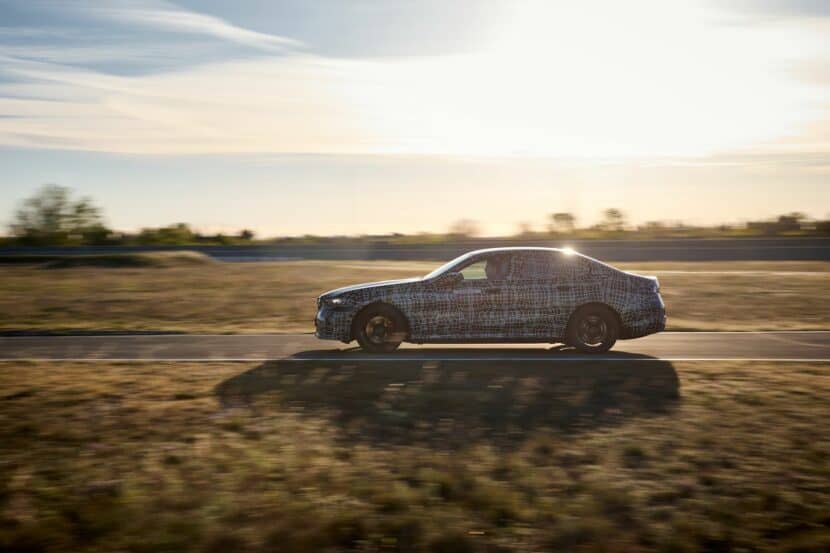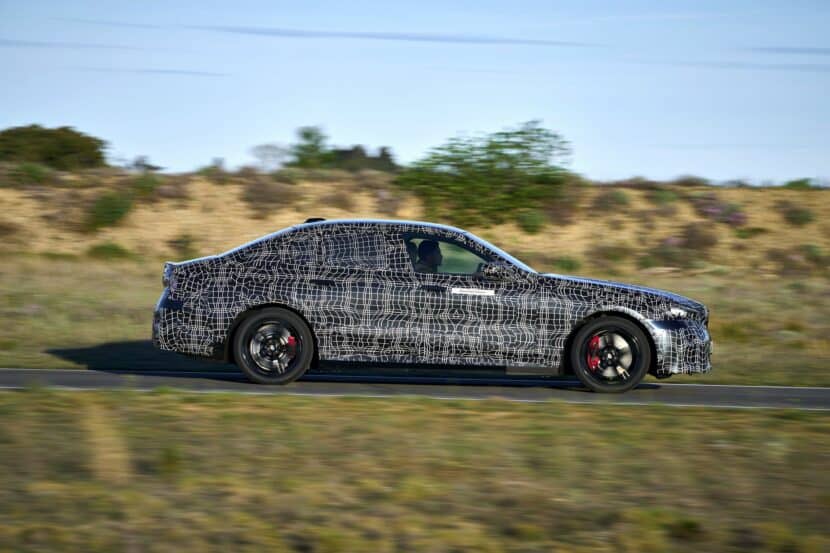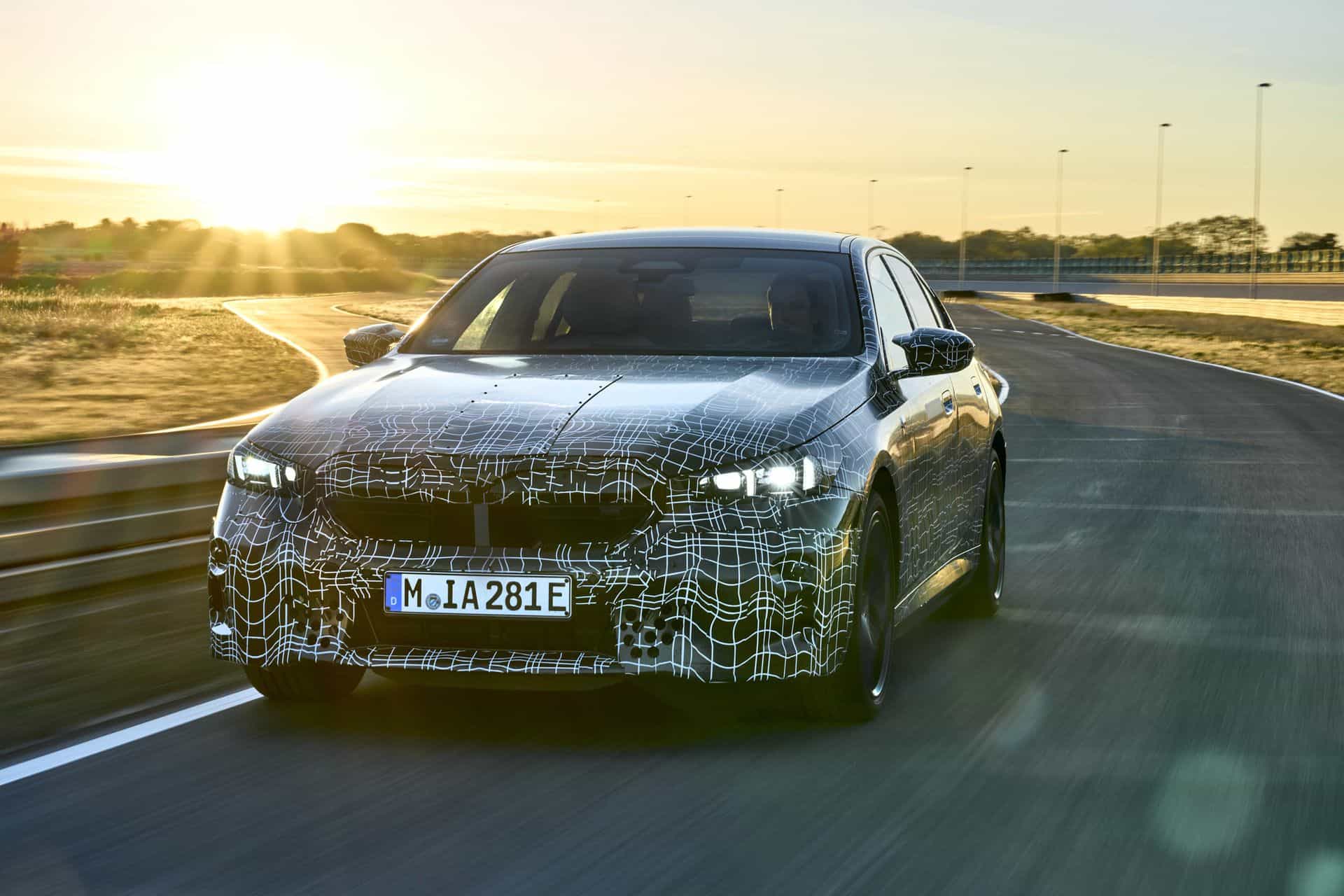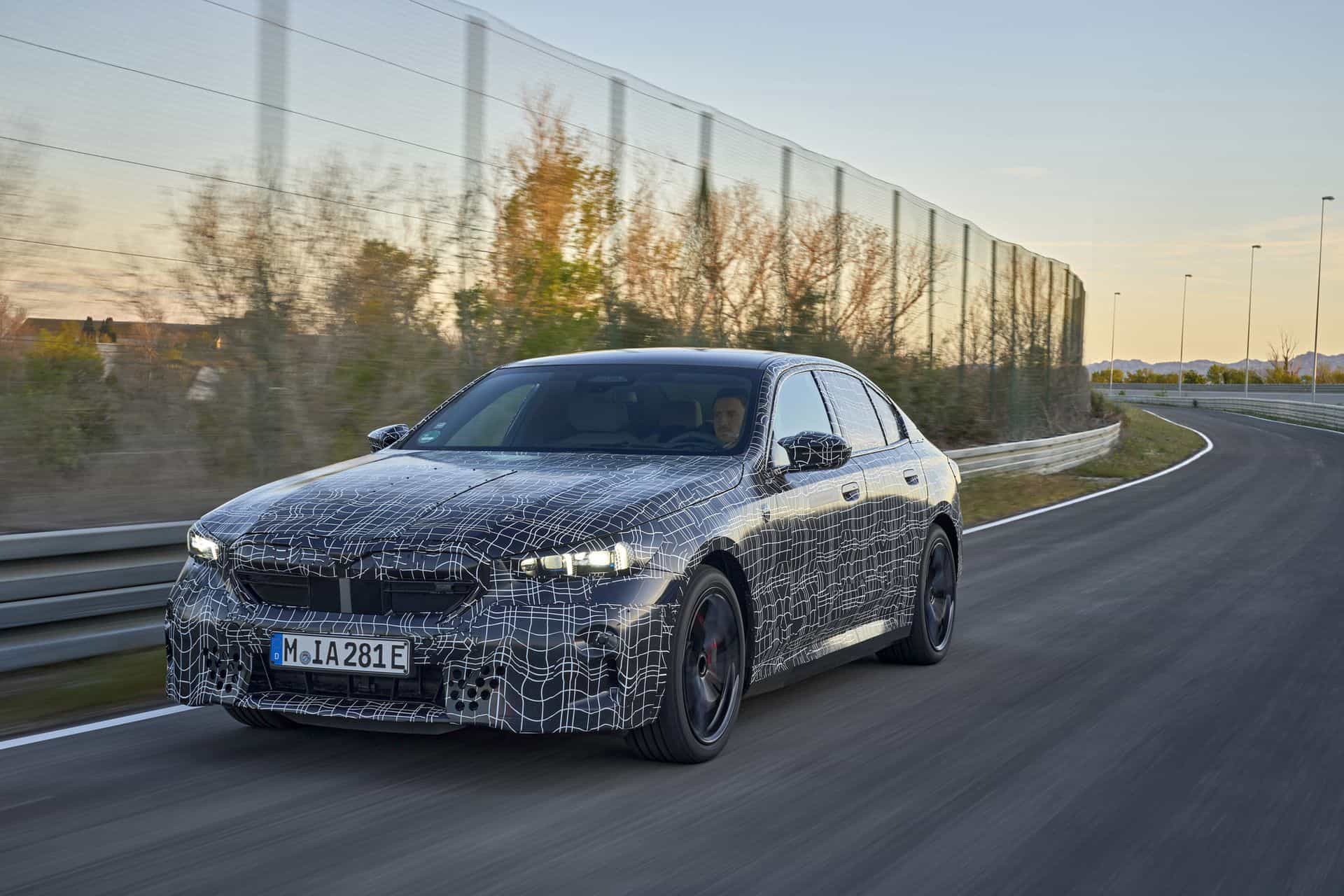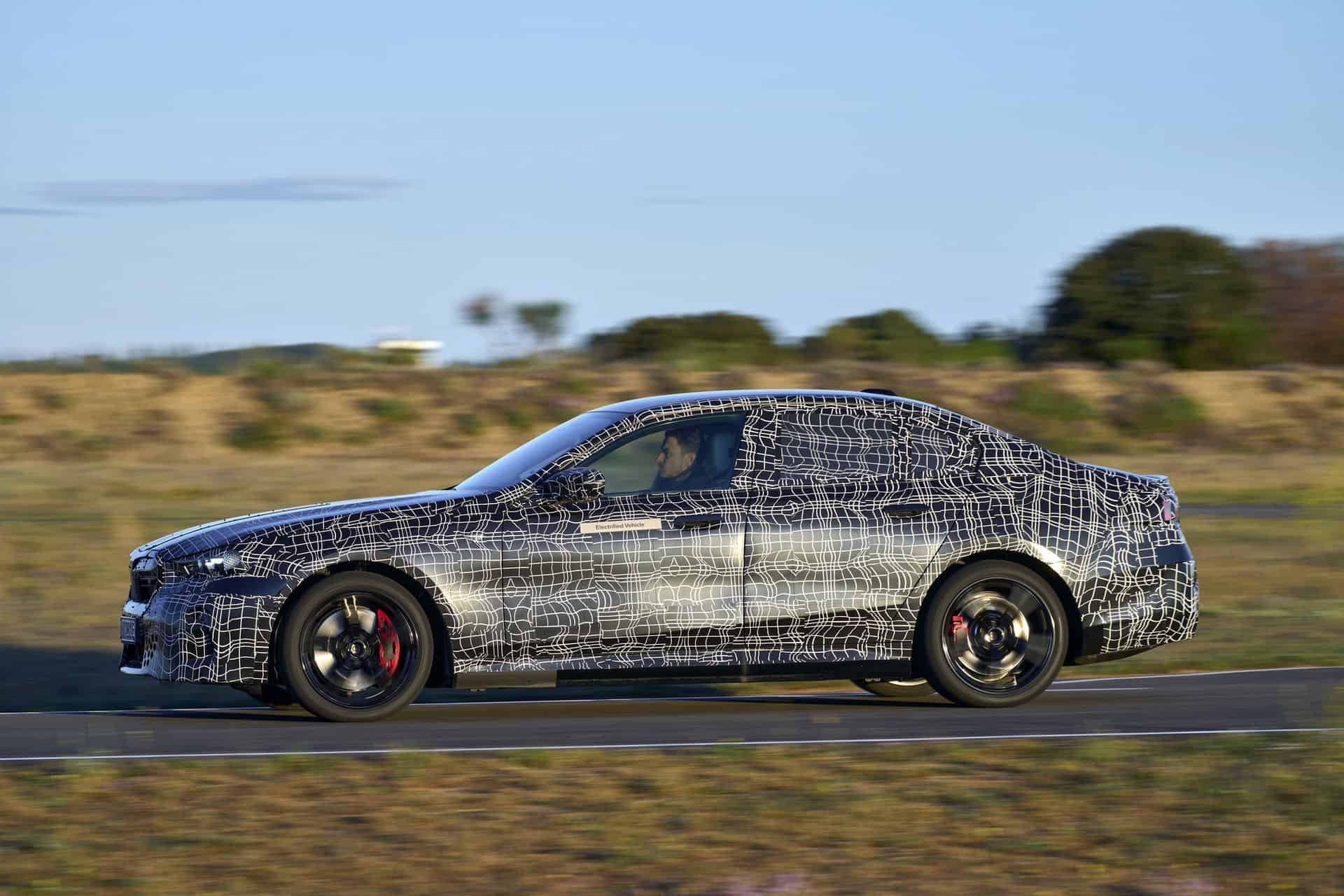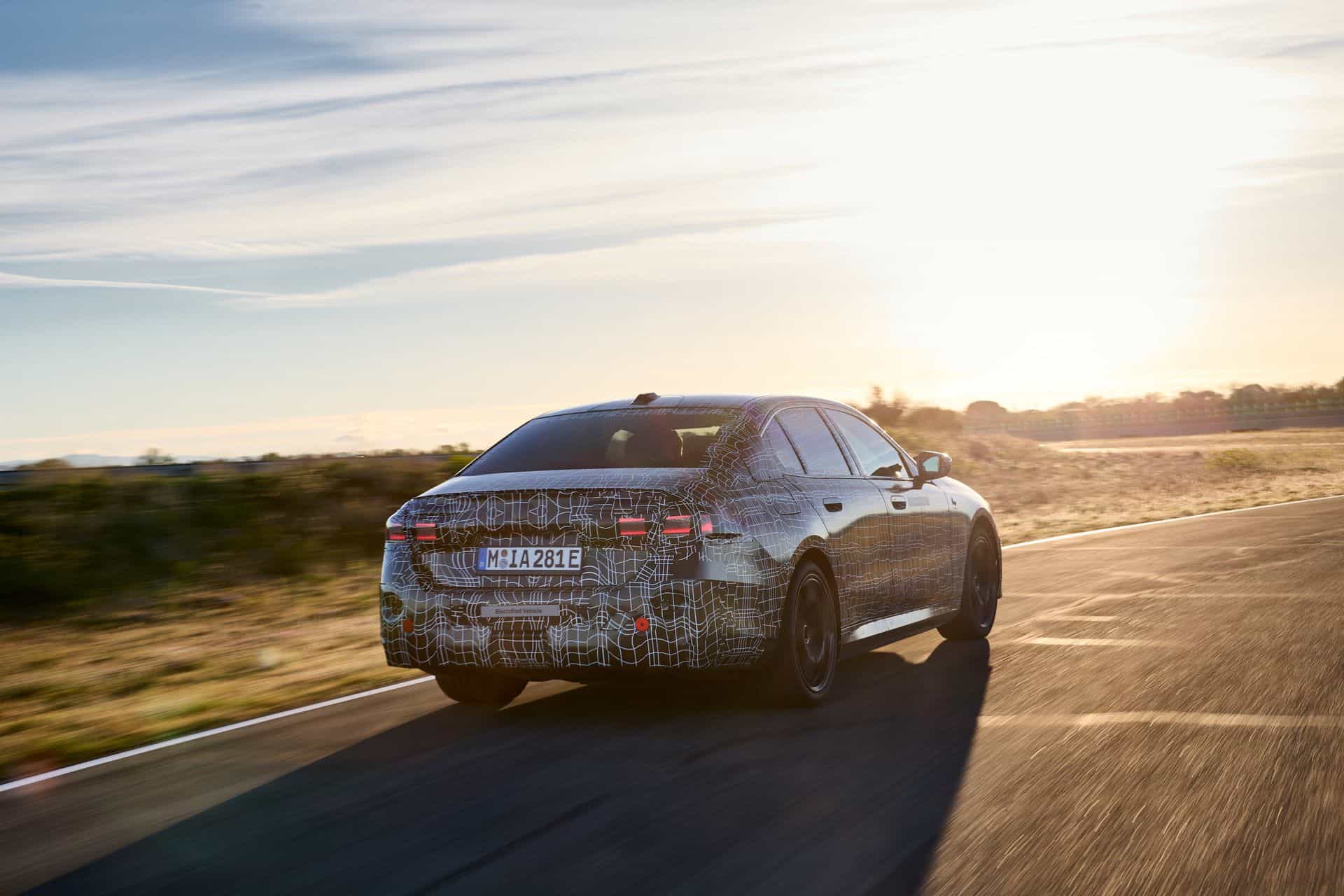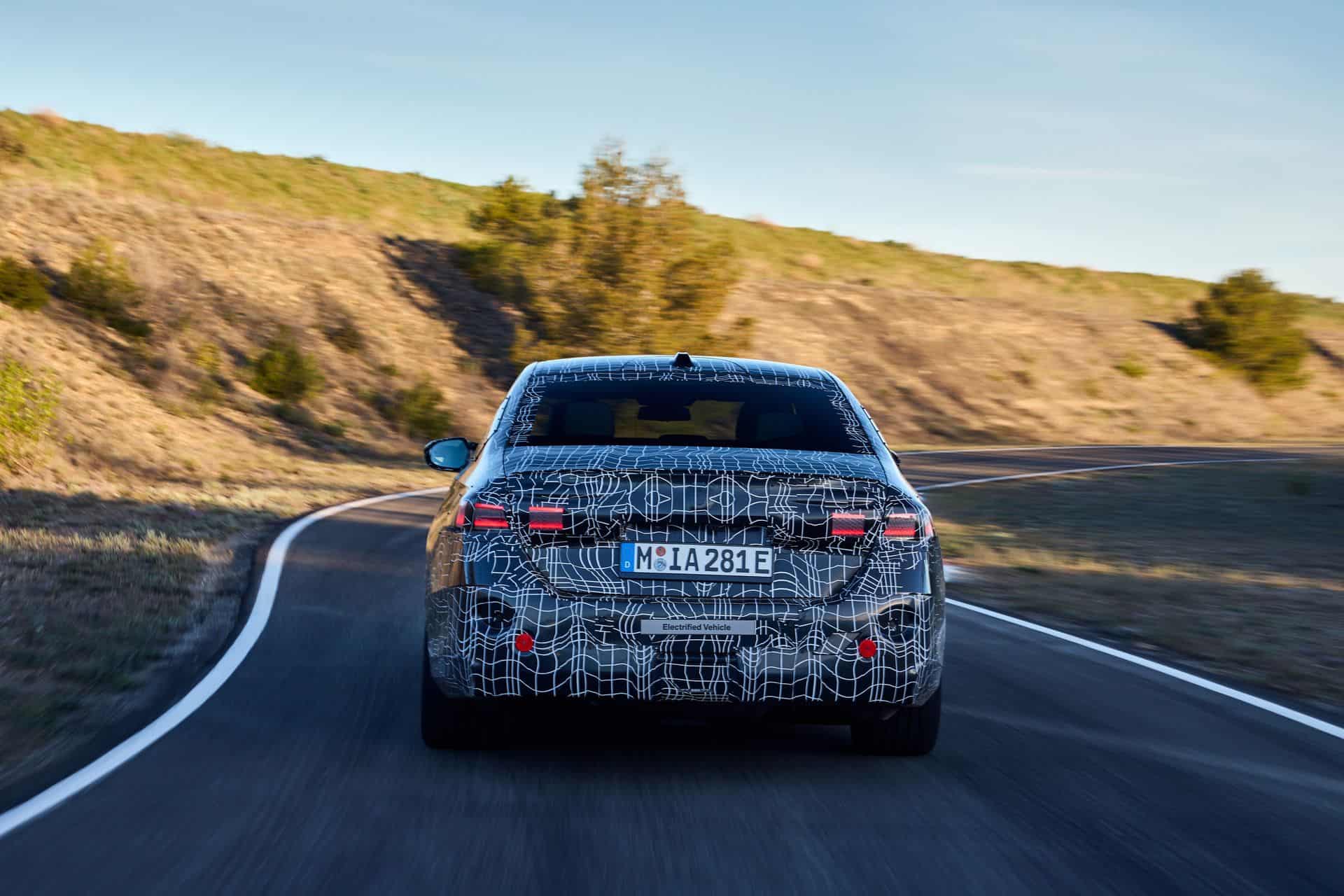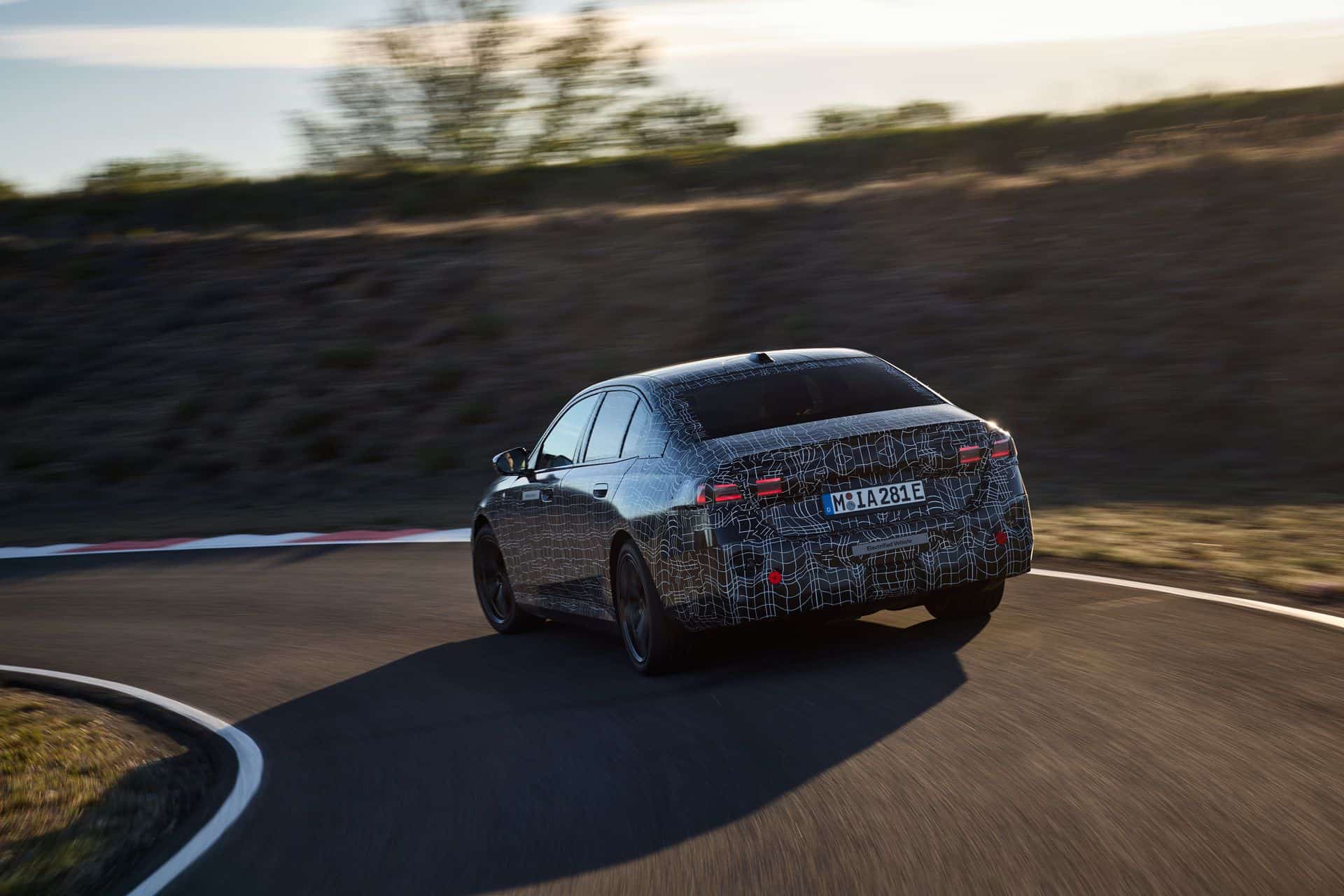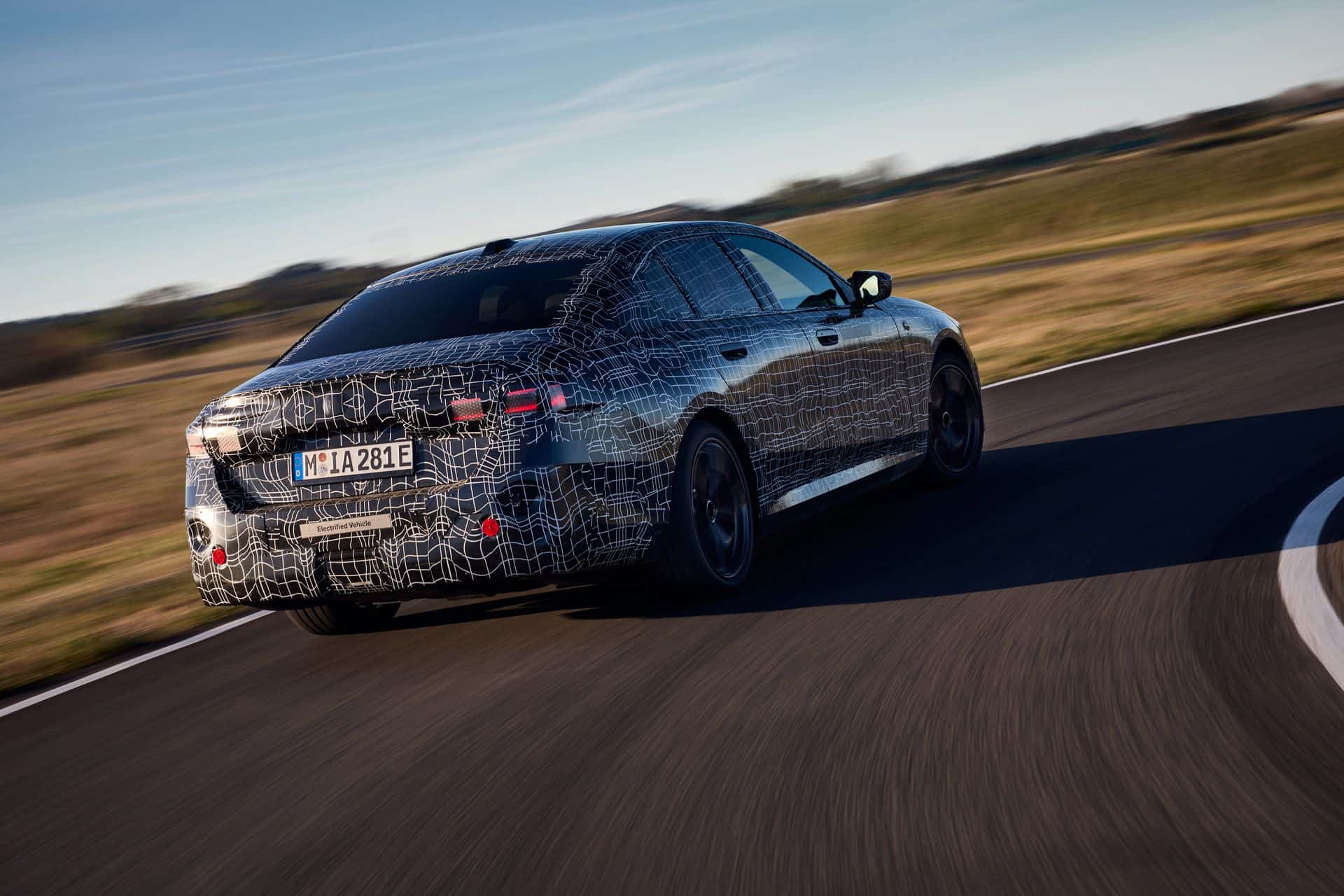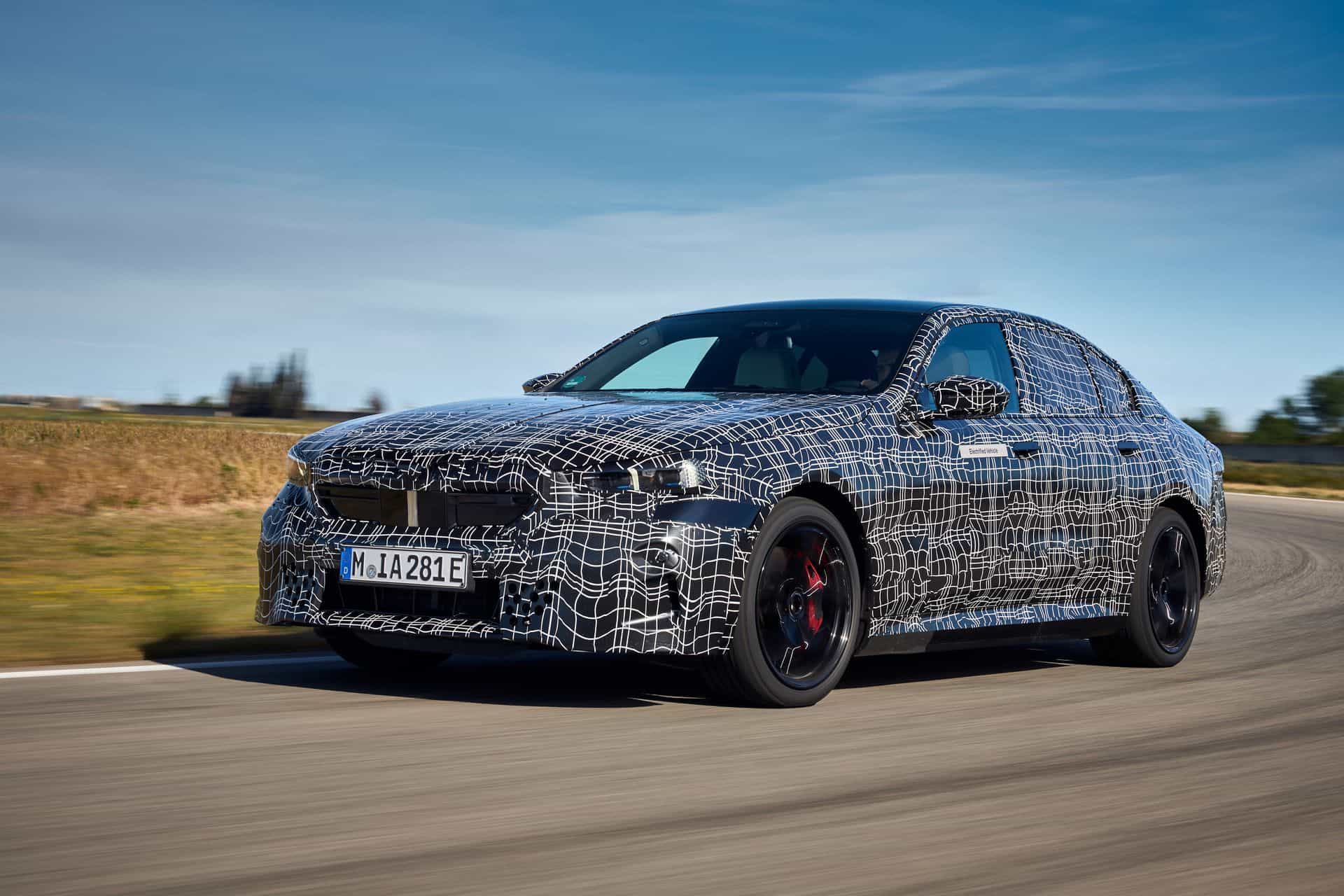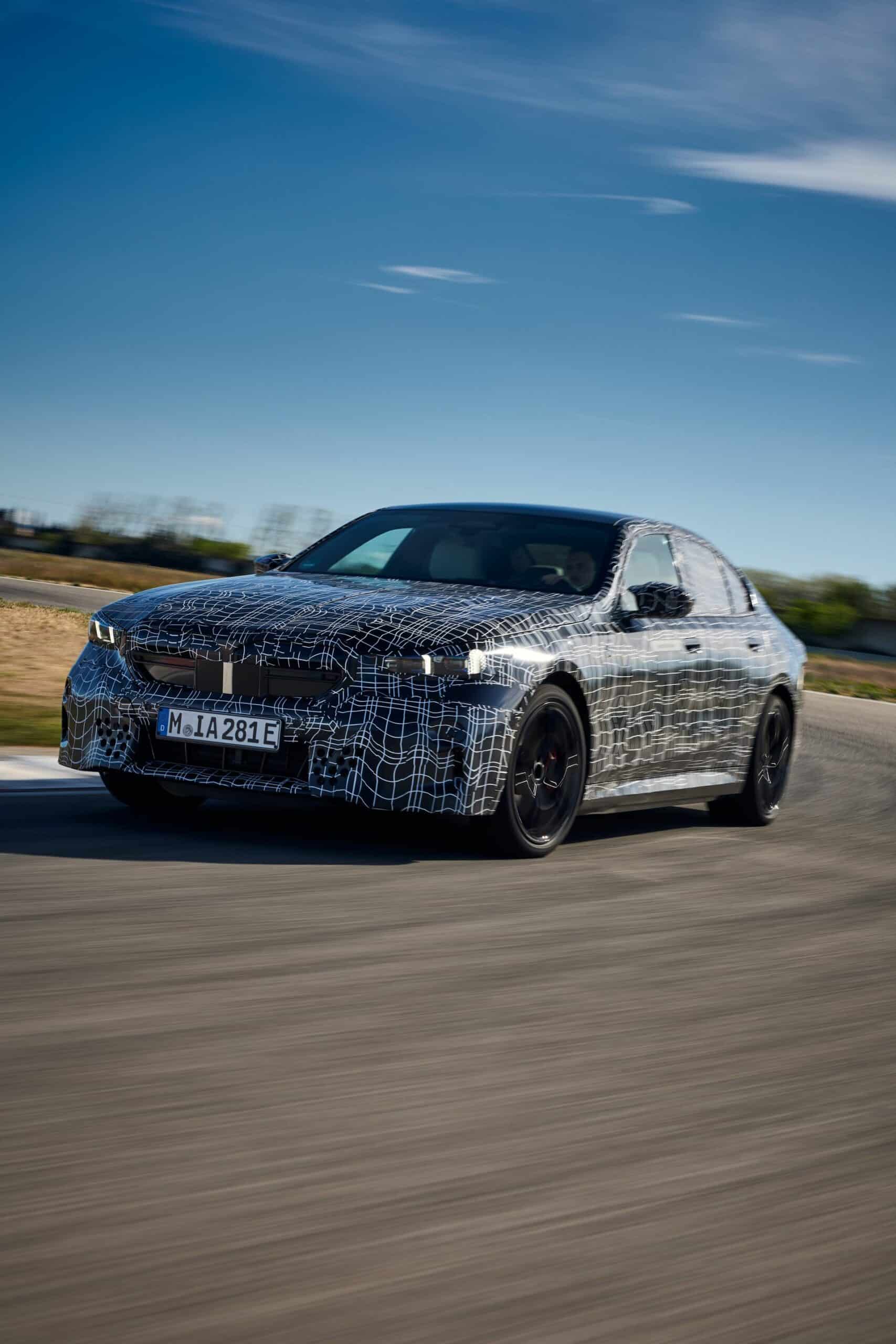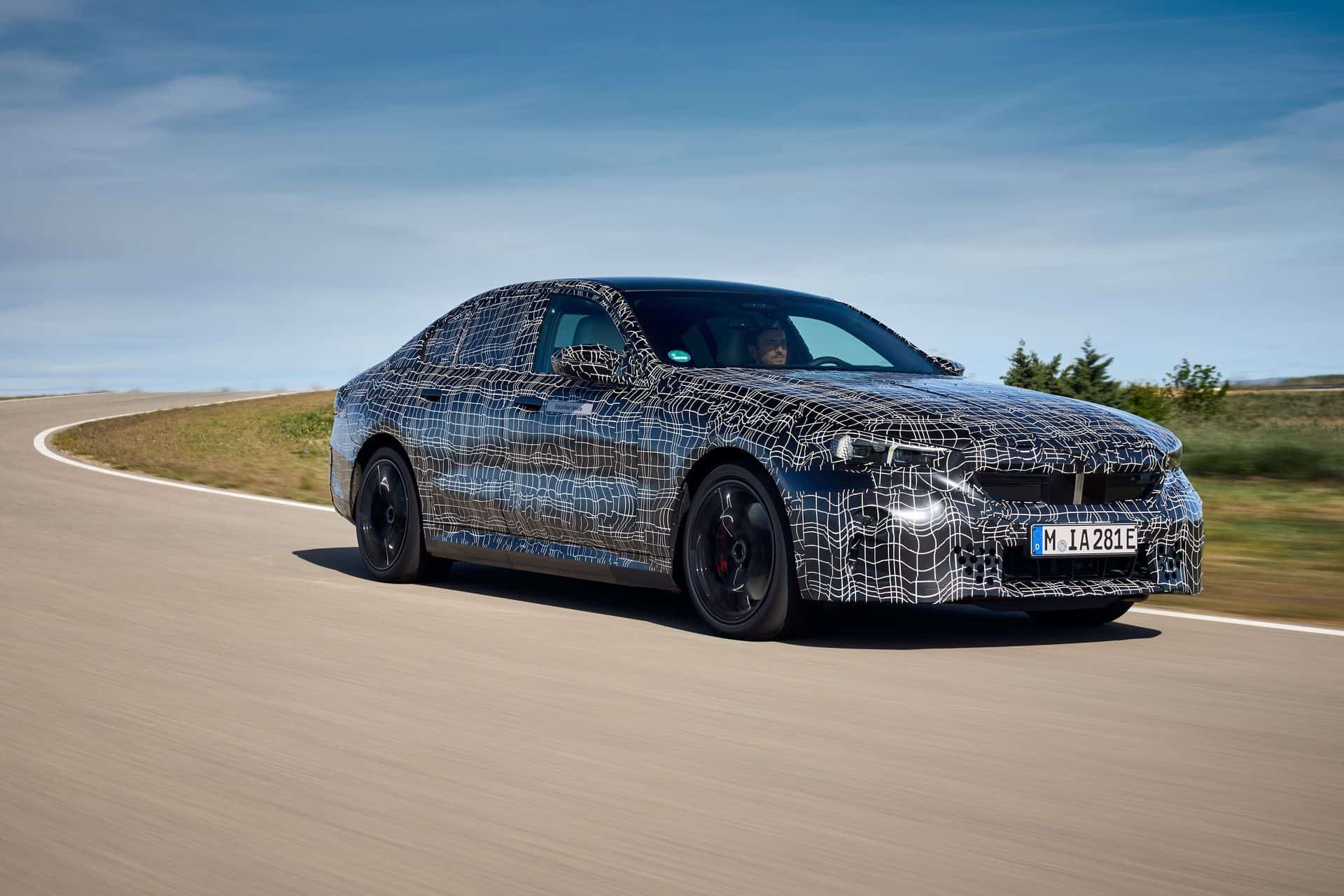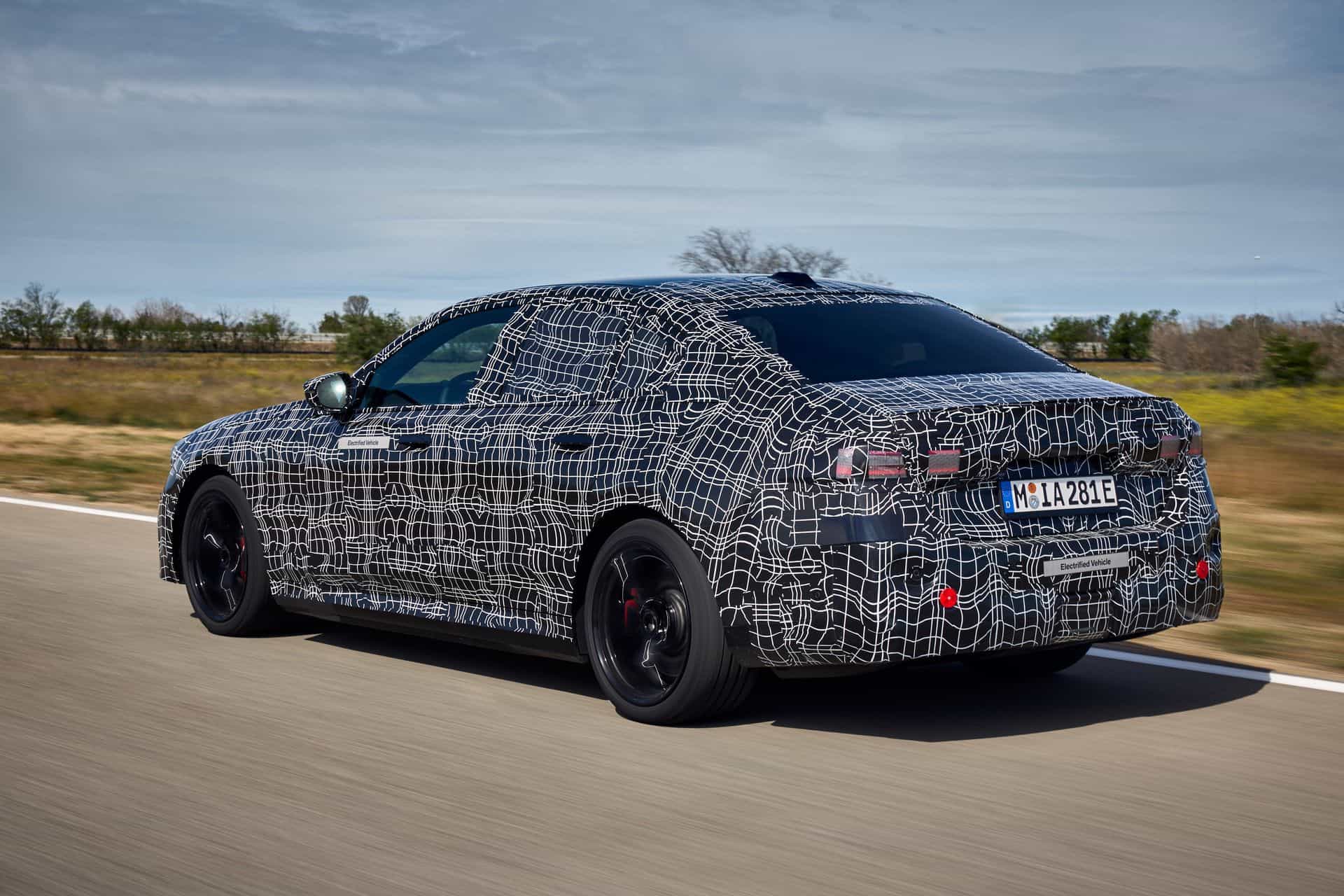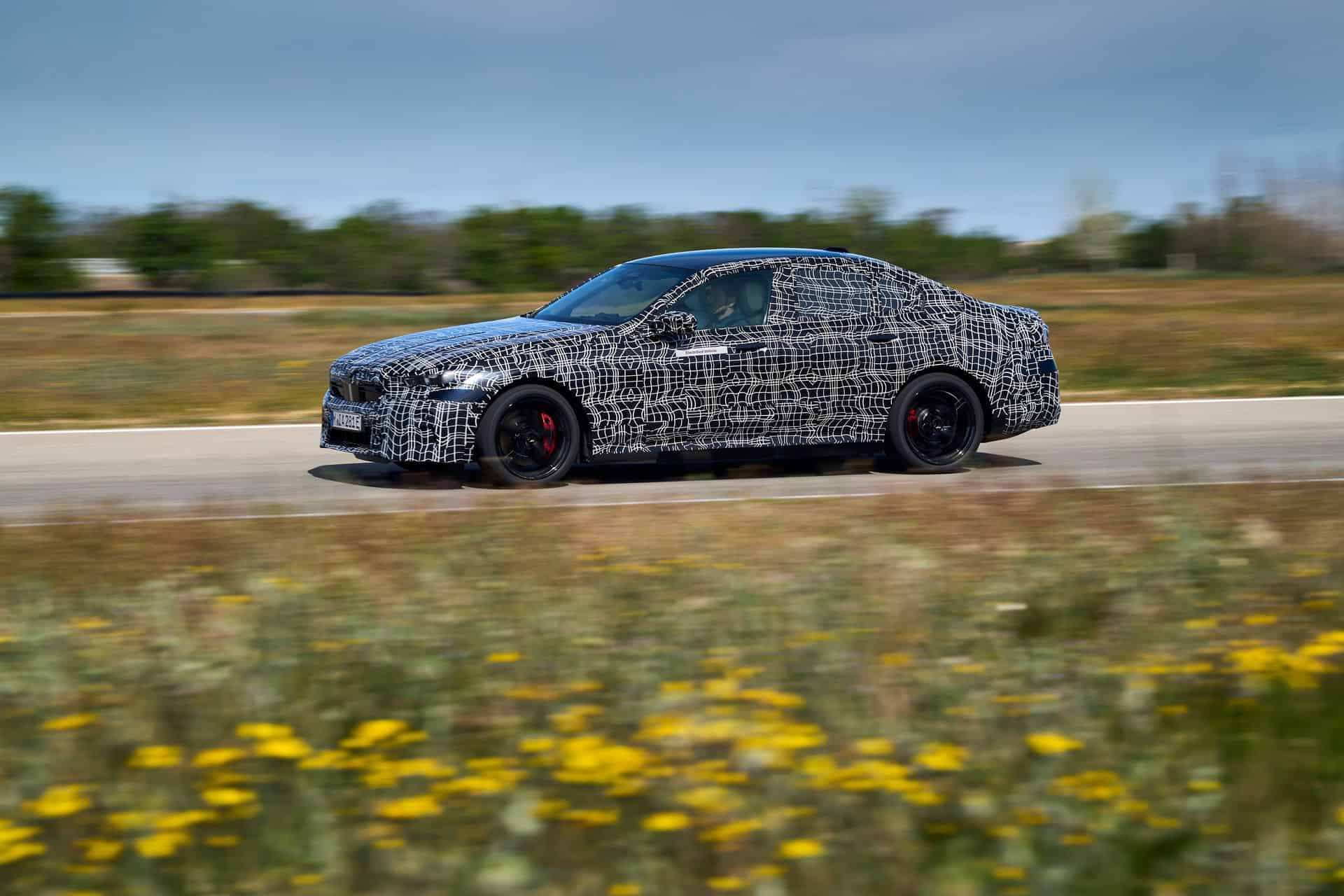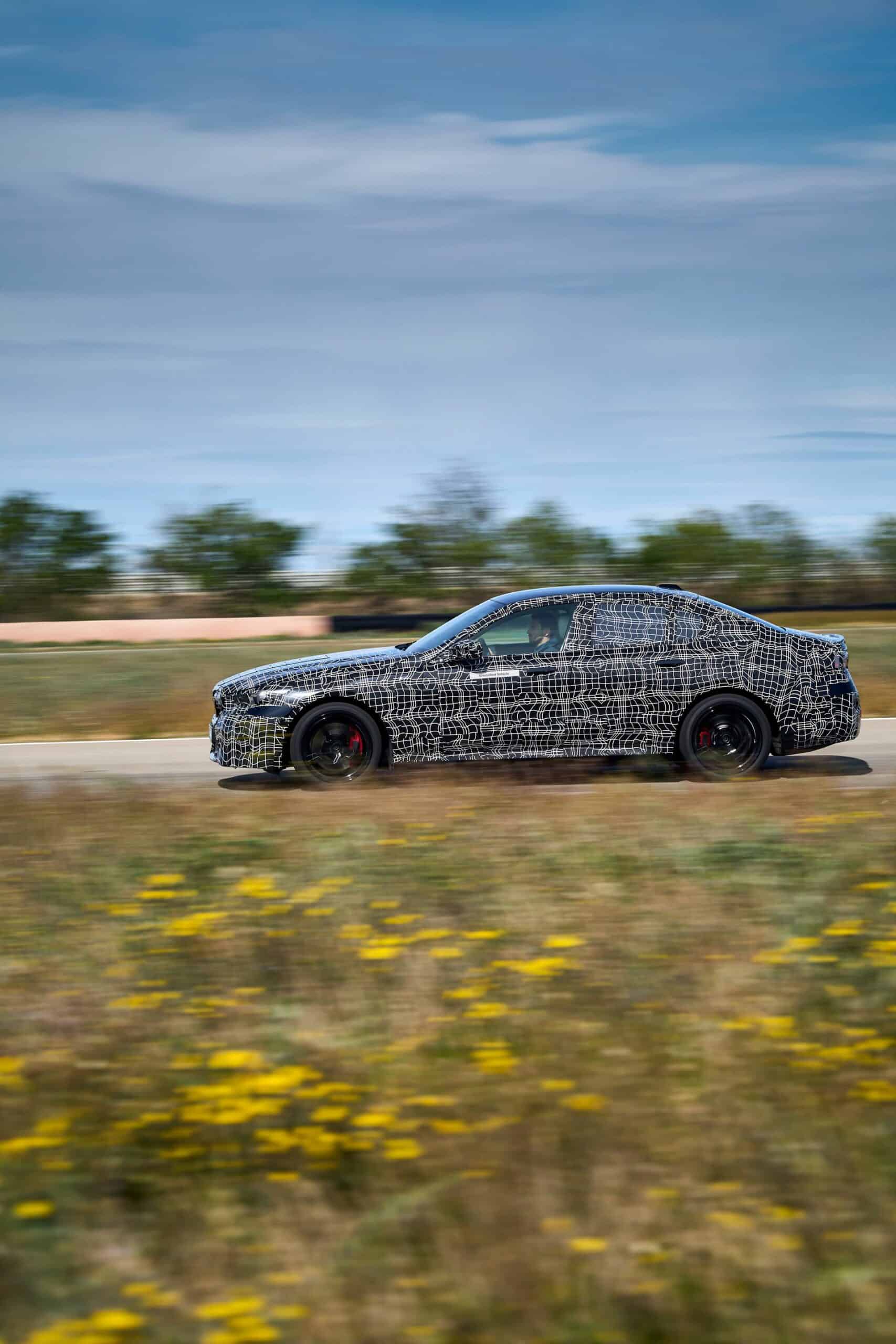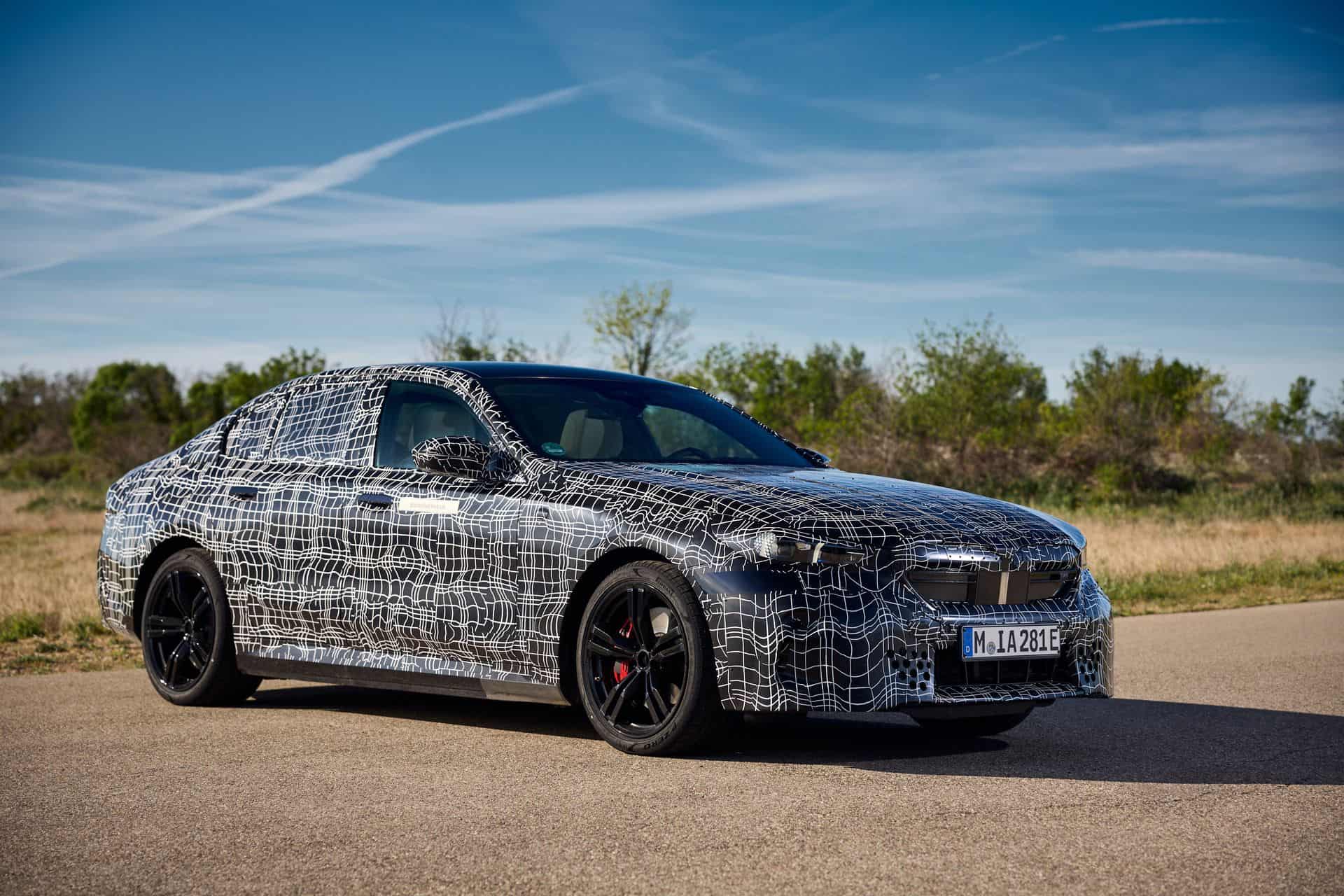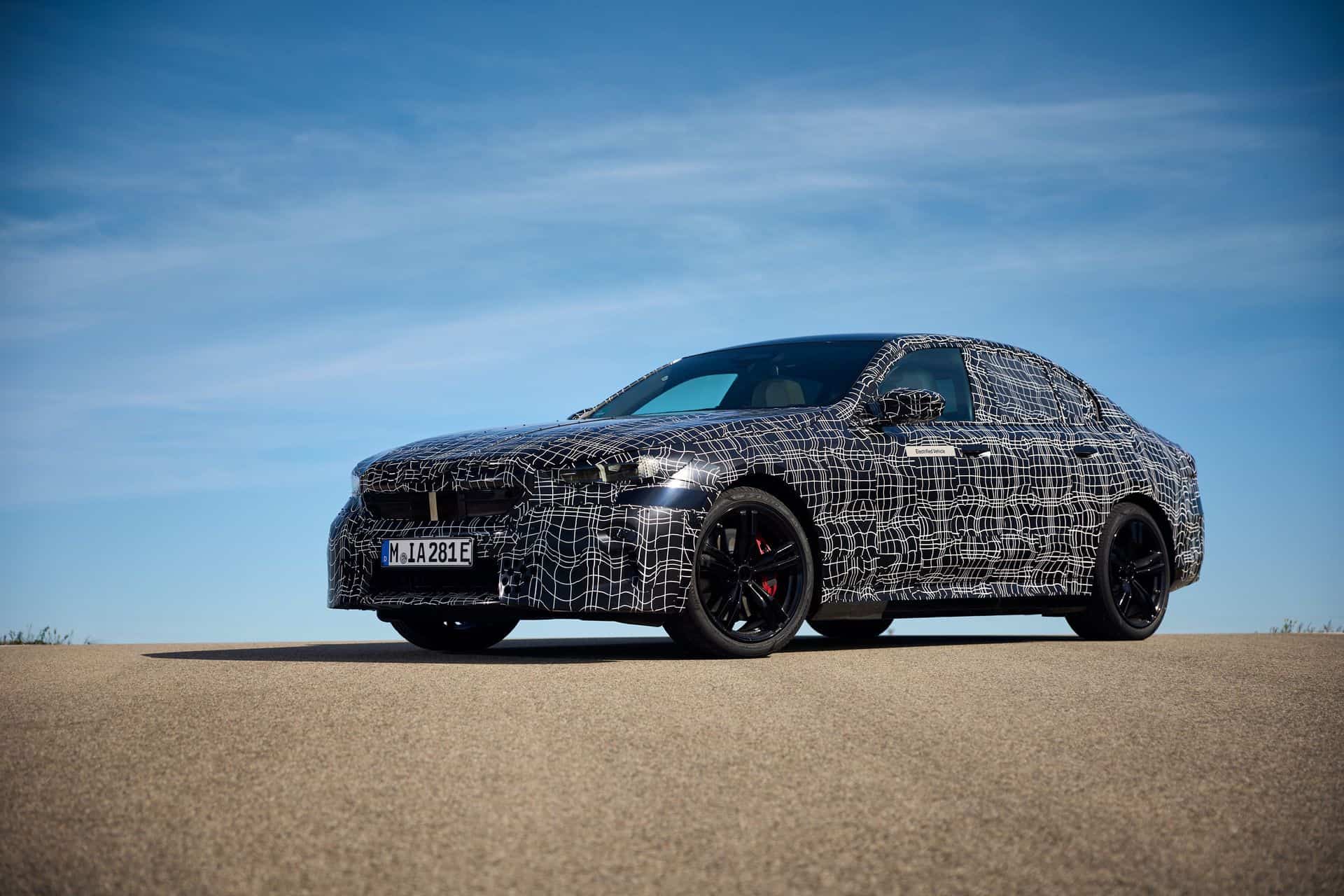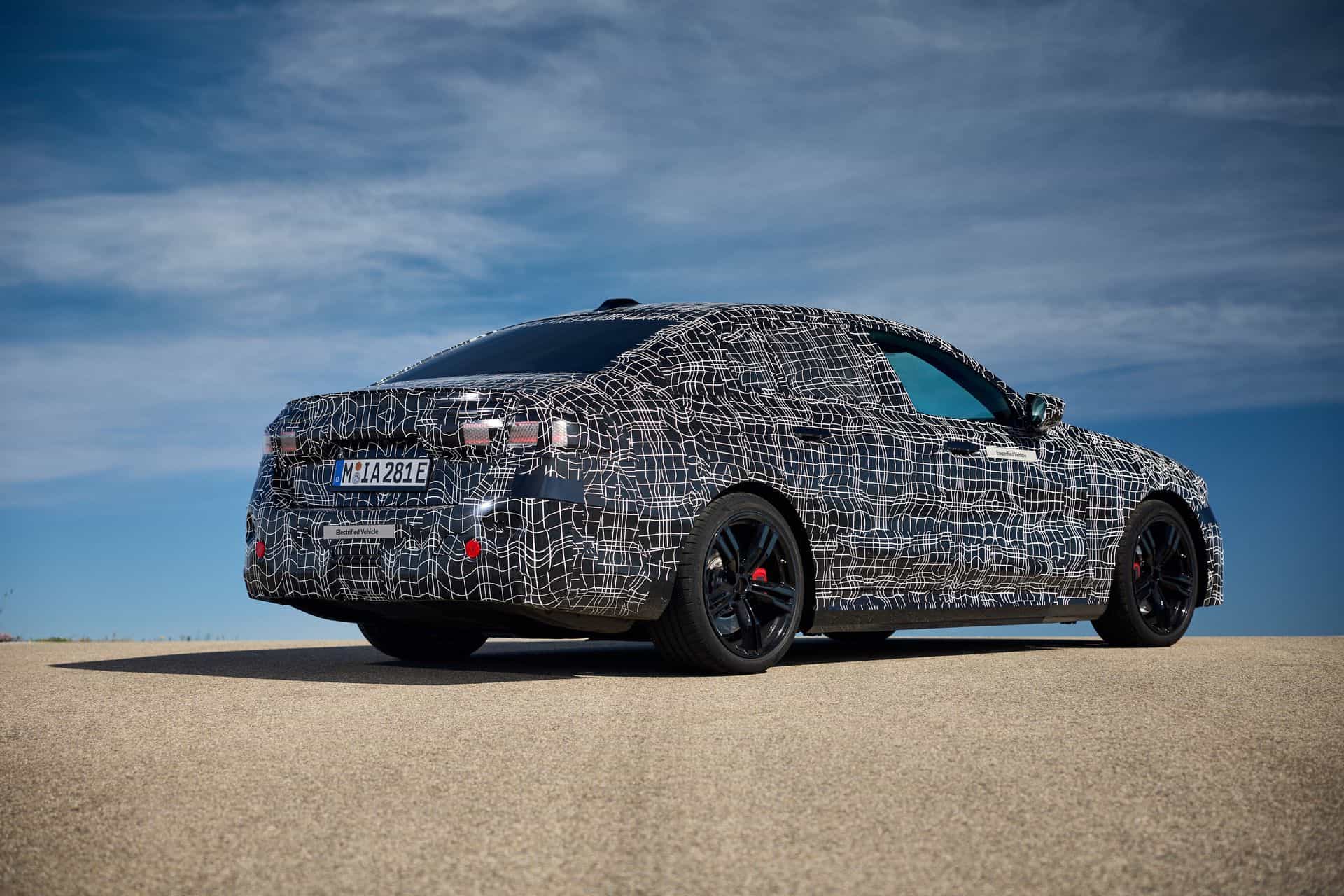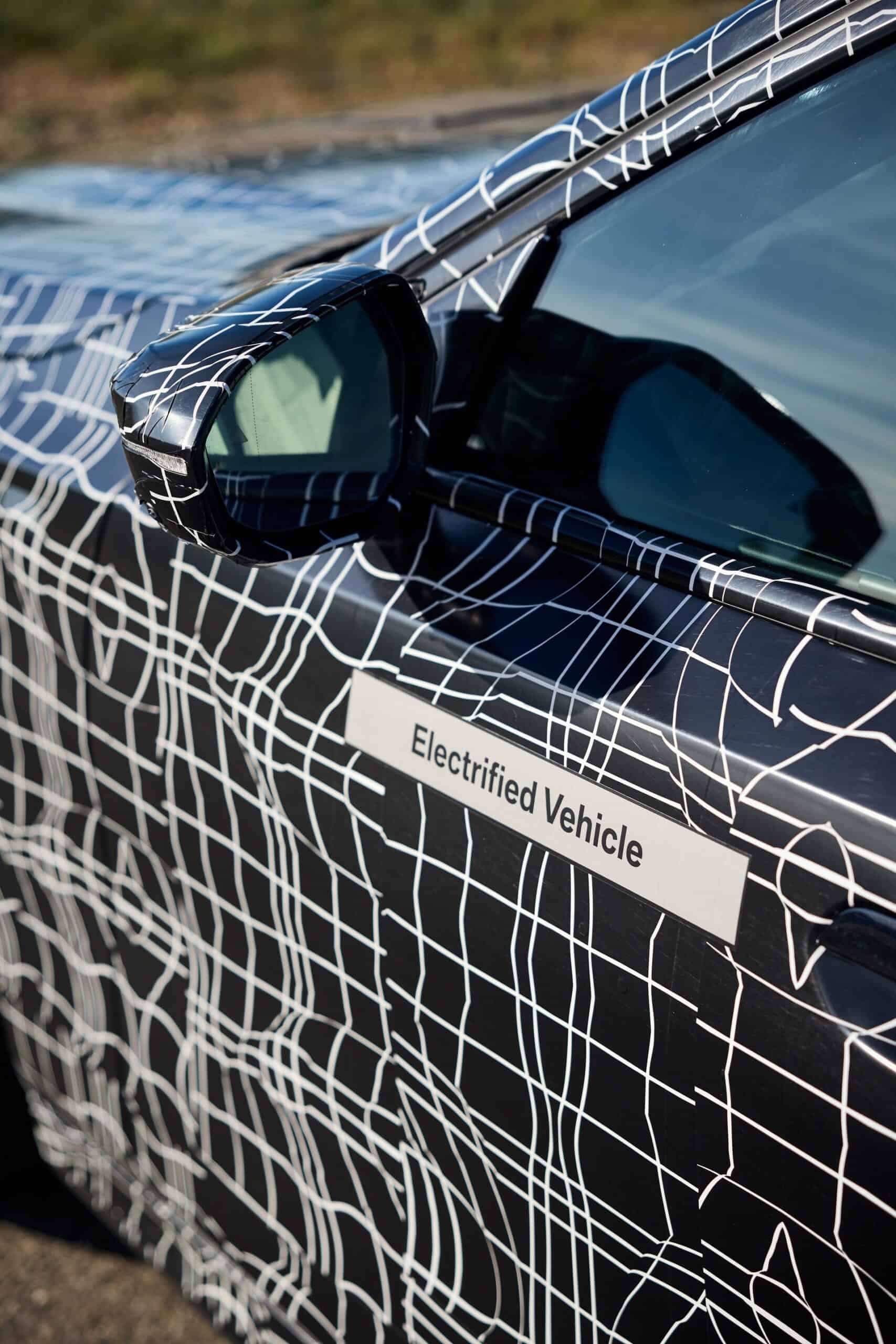In Southern France, lies Miramas – a secret BMW facility, where engineers have been testing BMW, MINI, and Rolls-Royce prototypes for decades. Once a Michelin testing site, BMW’s Miramas facility now feels like passing through an immigration check, with passport control, declaration forms, and mugshots. However, the experience is worth it as few outsiders get access. Here, we recently found the BMW i5 eDrive40 and top-of-the-line i5 M60 xDrive, both camouflaged and waiting behind gates and tight security. The goal of our trip was to spend some time on the road and on the track with the first-ever BMW 5 Series electric vehicle.
Like most pre-releases, BMW’s early reviews of their future cars are limited in terms of information shared. Details such as weight, dimensions, full power specifications, and straight-line performance are withheld, as are specifics regarding exterior and interior design. Yet, power specs and preliminary electric range figures are release. So let’s start with that. The BMW i5 eDrive40 is the entry-level model in the electric 5 Series lineup.
340 PS in i5 eDrive40, 590+ in i5 M60
The rear-powered i5 eDrive40 has a power output of 250 kW which translates to 340 PS. The estimated EPA rating is 295 miles, while the WLTP figures range from 468 to 582 km. The top of the line electric 5 Series, and likely of the entire lineup, is the dual-motor BMW i5 M60 xDrive. The two electric motors make a combined 440 kW of power with the actual horsepower numbers rated between 590 and 598, depending on whether you use the PS or HP figures. Unfortunately, BMW is not ready to communicate the EPA range for the i5 M60 but with a lot more power and equipment on board (read heavier), we expect that figure to drop below the 295 miles range of the i5 40. On the other hand, the WLTP comes in 436 to 516 km of electric range. The figures reflect the BMW i5 being equipped with aerodynamic 20 inch wheels.
Built on CLAR and Gen 5 components
As with the BMW i4 and i7, the new i5 is built on the flexible CLAR architecture which can accommodate the entire range of powertrains available from BMW: gasoline and diesel, plug-in hybrid and all electric. It also uses Gen 5 powertrains and battery packs, but no exact kWh were released at this time. But the one figure BMW was proud of sharing was the coefficient drag: 0.23 cd which is better than the former 5 Series.
BMW was also willing to share some technical details of the combustion-powered G60 5 Series as well. A five-link rear axle and double-wishbone front axle are standard on the car, as well as a steel suspension. Included in the rear is a directly controlled wheel slip limitation for faster reaction and better traction on the road. A compression strut connects the rear section and rear axle to increase stiffness of the chassis. Additionally, the variable rack geometry and acoustic decoupling in the steering system provides increased directness, precision, and feedback by reducing vibrations.
The brake-by-wire system comes with a high pressure ramp which under under dynamic movements gives more braking feedback to match the steering’s feedback. The brake discs measure 17 inches in the base models and also feature a lightweight construction. The wheel sizes in the new BMW i5 can go up to 21 inch wheels, but it’s the 20 inch 940M wheel which will give you the best aerodynamic properties.
i5 M60 fully loaded with tech
Regarding the BMW i5 M60 xDrive, the base configuration differs significantly. All BMW i5 models are now equipped with a standard rear axle air suspension. Notably, the battery pack is integrated into the chassis, as per BMW, to meet crash requirements and increase the battery pack’s stiffness, which enhances driving dynamics. This direct connection between the battery pack and the axles results in improved agility during lane changes and on racetracks.
The i5 M60 is also equipped with Integral Active Steering, which combines front and rear axle steering for improved agility at high speeds and maneuverability at low speeds. Additionally, it features Active Roll Stabilization, as seen in the BMW 7 Series and i7, which stabilizes the vehicle both vertically and transversely. When in Comfort mode, drivers can expect a more comfortable and plush driving experience, while Sport mode offers the dynamic driving behavior expected of a BMW.
Of course, we’re in a world of self-driving features so every automakers emphasizes that tech in their cars. BMW makes no exception with the new G60 5 Series. The cars come equipped with an 8 MP high fidelity camera. There is also a full range radar with a 300 m horizontal and vertical recognition. But that’s barely scratching the surface when it comes to drivers assistance features in the BMW 5 Series and i5.
Enhanced Level 2+ Features
BMW categorizes their driver assist systems under three pillars: Safety, Driving and Parking. Under the firs pillar, the new BMW 5 Series fulfills the NCAP 2023 requirements, including the recognition of scooters and motorcycles, collision warning with brake function for oncoming traffic and emergency braking when reversing. Let’s cover the last pillar before we talk about the most exciting one. So under the Parking category of assist systems, the BMW 5 Series will offer the well known Manuever Assistant with Remote Control Parking via the BMW My App. Additionally, you can spec the car with the Parking Assistant Professional and the Reversing Assistant.
My favorite upgrade on the new BMW 5 Series is the enhanced Highway Assistant with simplified user interaction. Now, all you have to do is press the I/O button on the steering wheel, look straight down the road, and when the Assist Plus message appears on the screen while on a highway, you can safely take your hands off the wheel. Additionally, the system recognizes when the driver takes over the steering wheel through a capacitive sensor. There is no longer a need to make slight steering movements for the system to acknowledge that control has been handed over.
The Highway Assist will overtake the speed limit automatically and the maximum speed in the hands-free mode is 85 miles or 135 km/h. In Germany, the standard is 130 km/h, but you can have an offset of 5 km/h, or up to 10 mph in the United States. You can now drive hours at a time without any driver interaction or input. BMW is also the first OEM to receive approval to offer the Highway Assist in Germany. The feature was already available in the United States and Canada.
World premiere: Automated Lane Change with eye tracking
Moving on to a world premiere feature not only for the BMW 5 Series but also for BMW and the entire industry: the Automated Lane Change. An eye-tracking device located behind the steering wheel allows drivers to automatically change lanes by simply moving their head to the left or right. The system undergoes multiple safety checks before initiating a lane change, including searching for a gap on the left or right side. Once a gap is detected, graphics in the dashboard indicate the availability of the maneuver, followed by an audio and visual prompt. To initiate the lane change, the driver simply moves their head in the desired direction, and the system automatically activates the turn signal and begins the procedure.
I had the opportunity to test the Highway Assist and the Automated Lane Change on a French highway, and I was impressed with their flawless performance. Although it takes some time to build trust in the Level 2+ features, particularly the lane change, once you become familiar with them, they become second nature. You can also the full demo video below.
BMW i5 eDrive40 on the road
Now, onto the thrilling part of the day. First, I got behind the wheel of the BMW i5 eDrive40 for an hour-long drive through small city centers and backroads. The purpose was to experience the entry-level i4 in typical daily scenarios and to sample its driving modes and brake regeneration. Similar to all the new BMW models, the G60 5 Series also features a wider gap between driving modes. In Comfort mode, the BMW 5 Series performs like a luxury business sedan with comfortable steering feedback and a plush ride that absorbs most of the road’s imperfections and changes in elevation.
In both Comfort and Sport, the benefit of a rear axle air suspension is obvious. It provides improved ride comfort and handling compared to a traditional coil spring suspension. The air suspension adjusts the stiffness and height of the suspension based on the driving conditions and evens out any uneven loads in the vehicle. This results in a smoother ride for passengers and better handling for the driver.
As expected, the i5 eDrive40 has an excellent turning radius, making driving on small roads effortless and comfortable. However, it’s at higher speeds where the real fun begins. Switching to Sport mode tightens everything up. The steering provides more feedback, and the front-end becomes sharper. Overall, the steering still lacks a bit of the engagement of previous BMWs and is still a bit numb on center. It’s fair to say that BMW’s modern cars have numb steering due to purposely damping road feedback using electronic steering racks. While the i5 has precise steering and good reaction from the chassis, it lacks road feel.
Moving on, the weight advantage of the rear-wheel-drive i5 compared to the all-wheel-drive i5 M60 becomes evident, particularly if you’re looking for more excitement on curvy roads. This is also why I tend to prefer the i4 40 over the more powerful i4 M50.
The power delivery of the BMW i5 eDrive40 is smooth and consistent, without the sudden jolt that some other electric vehicles provide. While the 340 PS might feel slightly less energetic than in the lighter i4 40, it’s still noticeably more lively than the heavier i7. When pushed hard, the rear end of the i5 eDrive40 is prone to playful movements, reminiscent of the iconic BMW driving dynamics, albeit without the accompanying sound.
The BMW i5 eDrive40 shares the same brake-regeneration system as other BMW electric vehicles, so there are no surprises there. In B mode, you get the one-pedal feel, and in D mode, you can switch between an Adaptive state and Low, Medium, and High settings. While the one-pedal feel is enjoyable, it may be excessive for larger vehicles such as the 5 or 7 Series, leading to motion sickness. In this case, it is best to let the Adaptive mode handle the brake-regeneration system for a more comfortable ride, pleasing both the driver and passengers.
BMW i5 eDrive40
MaxRange gives you 25% more range
The BMW i5 also comes equipped with Boost Mode, which provides short bursts of power for overtaking with ease. Additionally, the car has a new driving mode called MaxRange. To activate this mode, simply press the button and you’ll get up to 25% more electric range. However, the mode comes with certain limitations such as a reduced speed limit of up to 90 km/h, decreased engine power, and reduced seat and steering heating as well as ventilation in the car.
In summary, the BMW i5 eDrive40 is a classic 5 Series luxury sedan, but with an electric powertrain. While it may not offer the thrilling sound of a traditional engine, it compensates with instantaneous torque and a more exhilarating cornering experience. It is a great proposition in the segment and a car that could please a lot of customers who are looking for more space than in the i4, but less opulence than in the i7.
Speaking of that, even though the interior was covered up, a few things stood out. Firstly, the BMW i5 gets the flat-bottom steering from the i7, along with a large curved display powered by iDrive 8.5 and a simplified dashboard with less buttons than in the outgoing 5 Series. The center console is also inspired by the 7 Series and if you know BMW, that’s hardly a surprise.
BMW i5 M60 xDrive on the track
As the day progresses, I find myself at the Miramas handling course, now behind the wheel of the BMW i5 M60 xDrive. Accompanying me is Daniel MÖGELE, a BMW engineer in charge of the driving dynamics for the 5 Series. He has only one plea for the day – to go as fast as I want, but to take care not to harm his vehicle. I soon discover that this is his personal prototype used for daily testing and he needs it back in one piece.
I follow a BMW M4 ahead of me to familiarize myself with the track before gradually picking up speed. The aim of this exercise is to experience the driving dynamics of what could potentially be the fastest BMW 5 Series ever produced. Right from the start, it’s clear that this car is a powerhouse! With its 440 kW of power, the BMW i5 M60 delivers an incredibly smooth and gradual acceleration. However, just a gentle press on the accelerator pedal is enough to make this car feel like a rocket. Despite being heavier than the i4 M50, the added power is both remarkable and evident. While it may not boast the 650 horsepower of the latest BMW i7 M70, I have a hunch that it will be the swiftest of the lot.
In the i5 M60, the rear axle steering is a standard feature that enables the rear wheels to turn up to 2.5 degrees in the opposite direction. This creates the sensation of a reduced wheelbase and enhances the vehicle’s agility both on the track and on the road. Daniel explains that it’s not possible to increase the steering angle further as doing so would cause the turning point to shift towards the front and result in the rear overtaking the front. The rear axle steering works wonders at low speeds, up to 20 mph, and also aids the car’s driving dynamics at higher speeds.
During high-speed cornering, the BMW i5 M60 experiences some minor body roll due to its relatively large size as an electric vehicle. However, the BMW engineer informs me that this was intentional. The idea behind the i5, particularly the i5 M60, is to provide a driving experience with a natural and slight body roll, rather than being too responsive and jittery.
BMW aims to offer a car that is both responsive and agile yet still delivers a natural driving experience. The power is transferred from the front to the rear in a highly precise manner, depending on the driving situation. In sharp turns, the front end is highly accurate and precise, allowing for rapid turn-ins. When the rear end requires more grip and precision, the power is shifted slightly to the back, resulting in that classic BMW rear-bias driving experience.
Likely a low 3 seconds electric sedan
In straight lines, the BMW i5 M60 xDrive is SILLY FAST! Period. Of course, we weren’t allowed to do a instrument testing, but I’m confident in saying that this is a low 3 seconds car.
A proper high-power electric car should always come with a near-actuator wheel slip feature. ARB is the name and allows fully variable power transmission between the front and rear wheels. And just like with all rear-wheel drive-based BMWs, the i5 M60 xDrive has a RWD bias in normal driving scenarios. Of course, pushing the cars into corners delivers additional traction at the front-wheels. The Active Roll Bars adjust the load transfer playing along with the active dampers to deliver neutral driving feeling in every situation.
For the final part of the handling exercise, I tested the air springs on the rear axle by driving at high speeds over potholes and steep elevations. The springs are designed to be progressive, meaning that as they compress, the spring rates increase and level out the car. Even at speeds exceeding 150 km/h, when the i5 landed on the tarmac, it felt firmly planted to the ground. While the car can be a bit more responsive and twitchy in Sport mode, the air springs still perform exceptionally well, delivering a smooth and stable ride even in challenging driving conditions.
Once again, BMW set out to prove a point with the i5, and they certainly succeeded. They challenged me to drive on an extremely rough road, but even under these difficult conditions, the car felt composed and stable, effectively absorbing most of the imperfections on the road.
Unveil set for May 23, production Summer 2023
As the hour-long track exercise came to a close, I couldn’t help but have a big grin on my face. This was because the i5 proved that even though it was built on a flexible architecture that doesn’t prioritize electric vehicles, the driving dynamics were not compromised in any way. While it’s true that electric vehicles are often seen as lacking soul and being merely rocket-like, the new BMW i5 proves that it can also deliver the typical driving dynamics one would expect from a BMW – but with electrification.
The BMW i5 is a great driving car, and with a safe yet appealing design and good electric range, it is poised to be a top-seller for the company.
While there are still some mysteries surrounding the BMW i5, such as its exterior and interior design, charging rates, and other technological features, the wait for answers is almost over. The official world premiere of the i5 is set for May 23rd in the late evening for the United States, so stay tuned for more exclusive content!
In the meantime, I would like to express my gratitude to Miramas for providing me with an unforgettable experience, especially considering that I traveled for 38 hours straight from Shanghai to get behind the wheel of not just one, but two prototype BMW i5s.
2024 BMW i5
Good
- Great driving dynamics
- Level 2+ driver assist features
- Nearly 600 horsepower
Bad
- Electric range could be better
- Less engaging steering









